SWEIDA, SYRIA – On July 25, 2018, ISIS terrorists attacked Sweida City and villages in the surrounding countryside. The ensuing massacre, one of the bloodiest of the eight-year Syrian conflict, went virtually unreported in the West. The U.S. coalition, illegally occupying Syrian territory, turned a blind eye as the ISIS terrorists that they claim to be waging war on entered the seven villages to the east of Sweida City that were targeted for wanton bloodshed.
At 4 a.m. the terrorist group approached under cover of darkness. They encircled each village, posting snipers around the villages and along the straight road that connects them all, to prevent civilians from leaving or coming to the aid of others. ISIS fighters entered homes and murdered civilians — even children as they slept, unaware of the horror that was approaching. In Shbeki a disabled child was beheaded as he slept. In Shrehi “the roads ran with blood,” according to resident of the village, H. Saab (his full name is not given for security reasons), who lost 35 members of his extended family in the attack.
In September 2018, I visited three of the seven villages that had endured the July attack. Sweida is a province around 110 km to the south of Damascus. It is the home of the Syrian Druze community that has remained steadfastly loyal to the Syrian state and Syrian Arab Army throughout the regime-change war waged against Syria by the U.S. coalition, Turkey, the Gulf States and Israel for eight long years. Until this massacre, the Druze had rarely been catastrophically affected by the conflict. The SAA had successfully kept a check on ISIS advances into the heartland of this fiercely resilient province.
The attack was given cursory coverage by most in the media; it was certainly not marked as one of the most heinous crimes committed by a terrorist group that was effectively enabled and protected by the U.S. coalition embedded in Al-Tanf, 330 km to the northeast of Sweida City and the targeted villages. ISIS fighters moved in from the direction of Tilal Al-Safa, a volcanic desert region situated around 100 km from Sweida City, again to the northeast. At no point did the Al-Tanf military base, bristling with surveillance equipment, detect or react against the ISIS operation. At the time, acclaimed Middle East journalist Elijah Magnier pointed out: “ISIS knew it was possible for its convoy to drive under the eyes of a superpower state [the U.S.] without being disturbed.”
As always, the true victims of this eight-year war will be brushed under the carpet while the focus remains upon the whitewashing of the perpetrators of the crimes against the Syrian people – the “rebel”-washing of the terrorist gangs who have been enabled to roam freely across Syria by the U.S. coalition and its Gulf State financiers of the sectarian ideologues described by the colonial media as “moderates.”
During our drive down to Sweida, I asked our guide, H. Saab, what he believed to be the motive behind these brutal attacks; he responded:
I believe it was to force the SAA to reduce pressure on the ISIS terrorists holding out in Yarmouk Basin close to the border with the illegally Israel-annexed Golan territories. ISIS are given protection in the 55 km buffer zone surrounding the camp and the Syrian Arab Army is not allowed to enter this zone, despite it being Syrian territory. Perhaps it was to allow ISIS an escape route to the U.S. base at Al-Tanf and the buffer zone area where they would receive equipment and protection from the U.S Coalition”
H. Saab also suggested that ISIS may well have wanted to actually take control of the villages, as they would have provided a stronghold that was easy to defend, offering high-ground and networks of ancient caves and underground passageways that could be converted into bunkers and shelter from bombing and artillery fire.
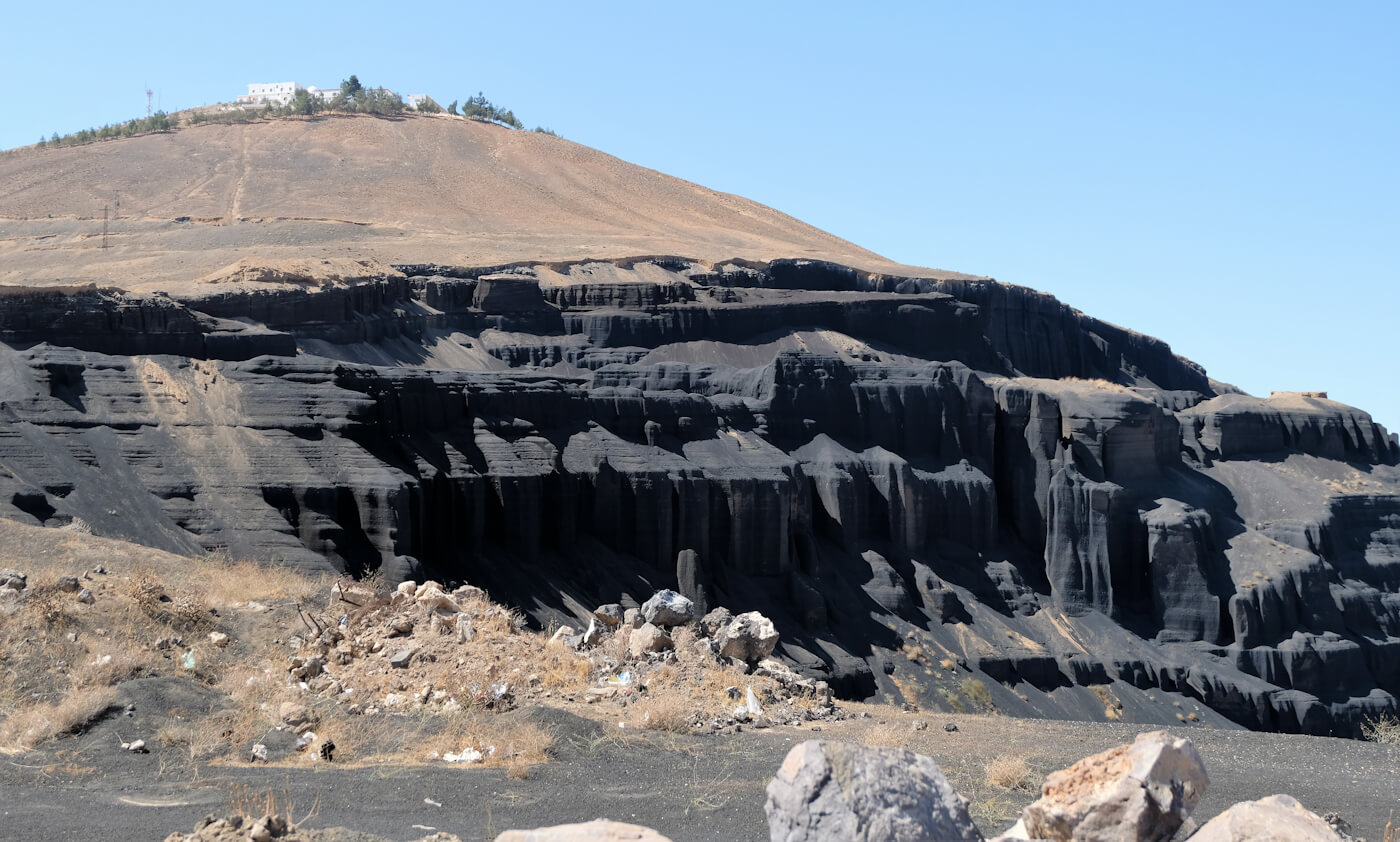
The basalt mountain on the road to Sweida. Photo | Vanessa Beeley
Sweida does have an other-worldly aspect to it: the vast stretches of desert, the hillsides dotted with fruit trees and the beautiful basalt mountain that rises out of the ground like a massive, glittering obelisk by the side of the road taking you towards this historically rich Byzantine region. Towns and cities date back to the first century B.C., during which time many were famous for the quality of their wines: Sweida was called Dionysias during Hellenistic and Roman times; Dionysus is the god of wine and the excellent reputation of this ancient wine-producing region persists today.
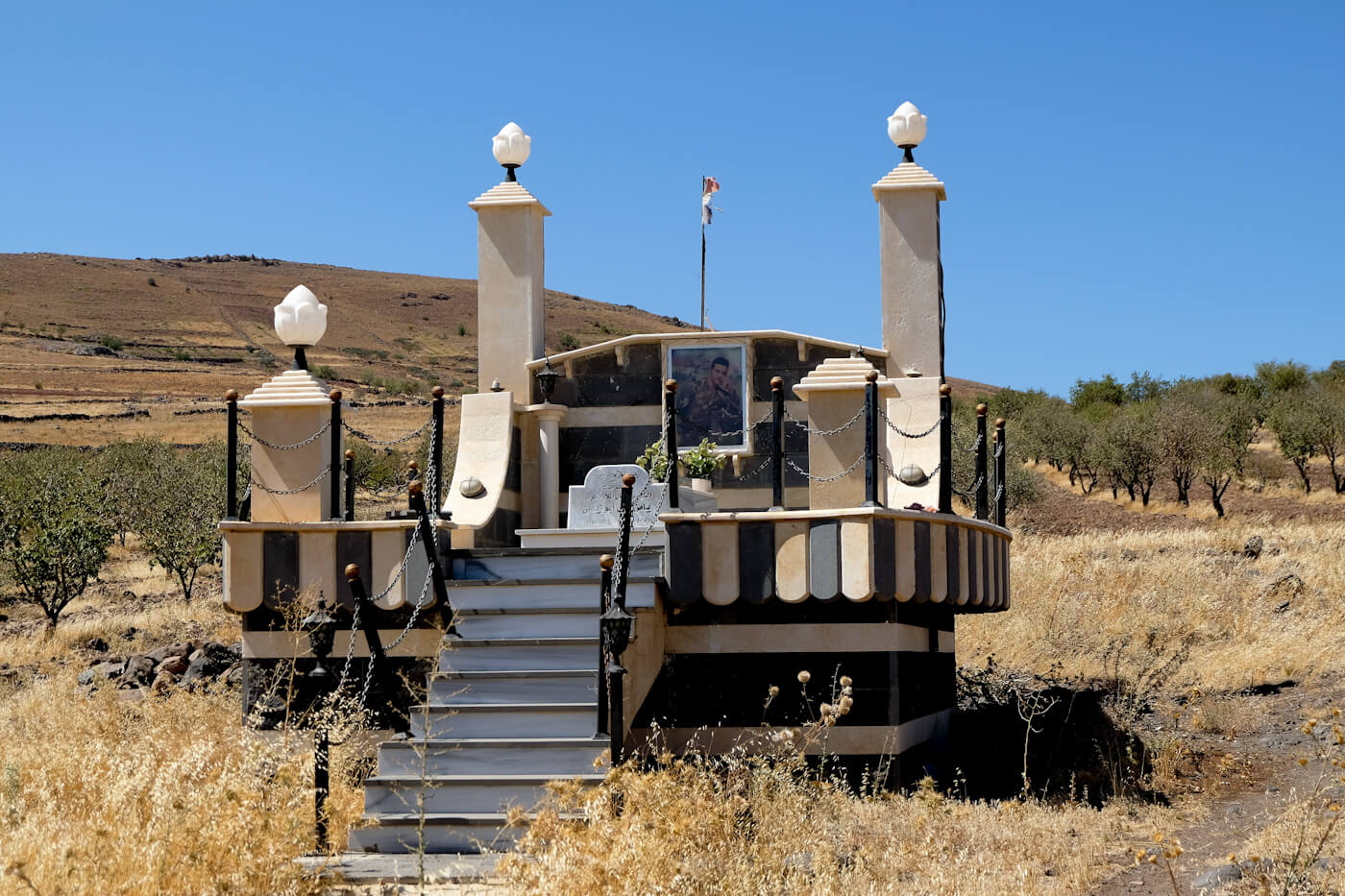
One of the many memorials to martyred soldiers in Sweida. Photo | Vanessa Beeley
I described these surroundings in a piece I wrote in October, “Sweida: A Bloody Massacre Barely Registered by Western Media as ISIS Slaughter Innocent Civilians in their Sleep:”
As we entered the province of Sweida, we began to see the elaborate memorials to martyrs killed in Syria’s war against Western-sponsored terrorism. Our guide told us that these beautiful monuments are in honour of the soldiers who have given their lives in defence of their homeland. Many of these impressive structures are placed at the entrance to villages ‘so their names are remembered for eternity by all those who live because they died.’
We were told that some of these graves also date back to the 1925 ‘Great Syrian Revolt or ‘Great Druze Revolt’ against France. They are wonderful to behold, rising out of the dry desert plains, backdropped by the hills and trees that pepper the landscape stretching out in front of us.”
In September, a pall of grief still hung over the villages, and an understandable anger at the bloodbath they had endured. The anger was largely directed at the U.S. and its allies, particularly Britain. The overriding sense was one of a massacre that could have happened only with the U.S. collusion and collaboration with the ISIS terrorist entity Washington claims to be combatting. The implications of this belief are huge — the raison d’etre of the U.S. coalition in Syria is the “elimination” of ISIS, yet here we have civilians telling us that, in their informed view, ISIS has been protected and its power multiplied by the U.S. in Al-Tanf.
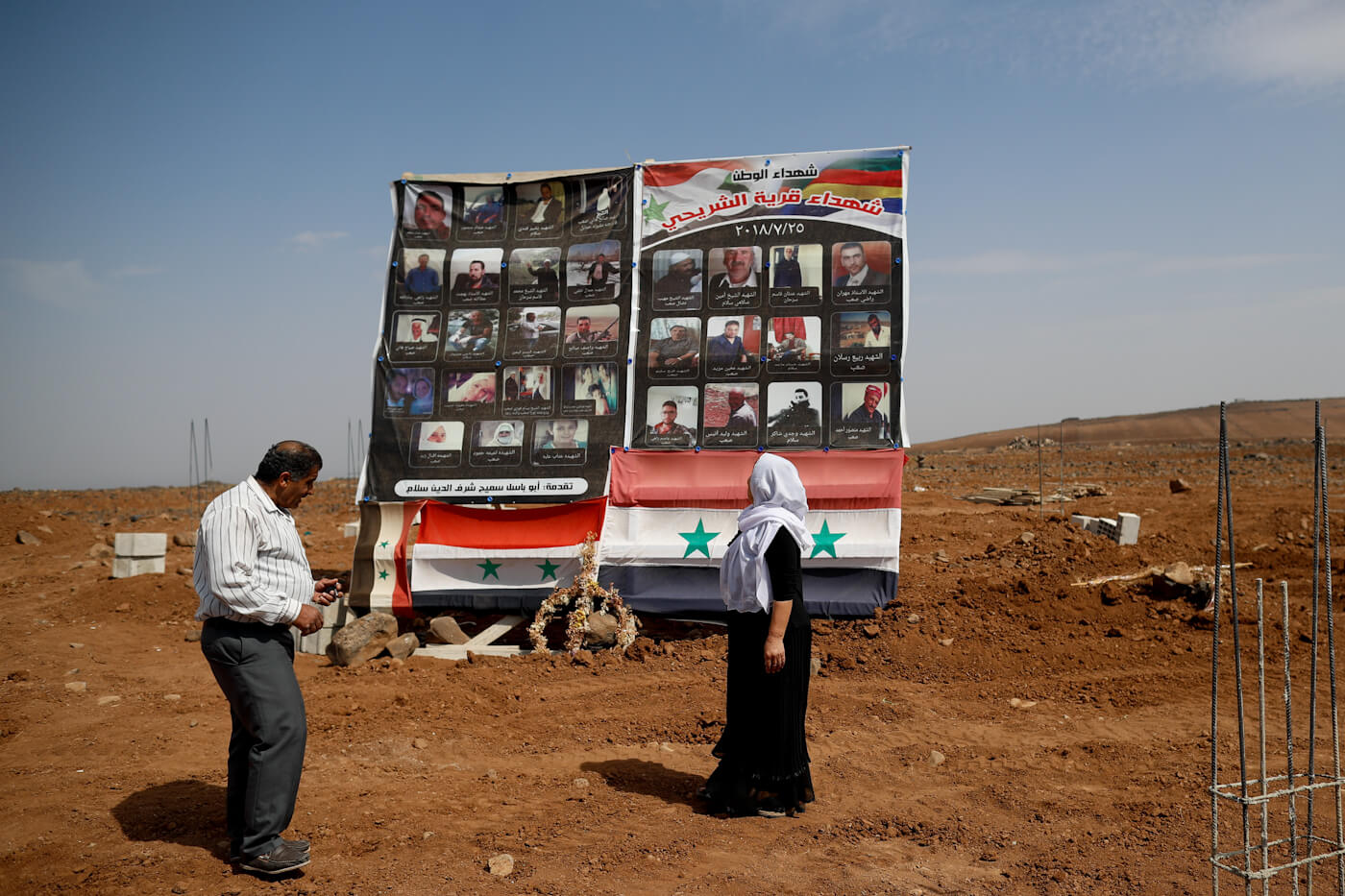
A Druze family visits a memorial erected to honor those killed in an ISIS attack on Sweida, Syria. Hassan Ammar | AP
Two-hundred-and-seventy civilians were massacred during the few hours that battles raged between ISIS and civilians, many of whom were armed with nothing more than hunting rifles. Three hundred more men, women and children were injured. Homes were entered by ISIS from 4 a.m. onwards, their inhabitants brutally murdered. The same homes were taken over as sniping nests by the terrorists, and from these vantage points ISIS picked off the dozens of young men who flocked to defend their towns once the initial shock of the attack had dissipated:
Many of our young men, women and children bled to death in the street. Nobody was able to get to them or to transport them to hospital. If they tried, they would be sniped.” – Khaled Saab
Khaled Saab’s mother, father, brother and cousin were martyred in the attack on the village of Shrehi, where 37 civilians were massacred. Khaled told me that he believed the ISIS fighters were high on drugs, very possibly Captagon. “We fired many bullets into them, but they kept fighting” he said.
In January 2017 “at least 137 kg of Captagon — dubbed a ‘jihadist drug’ and ‘the drug of the Syrian conflict’” — was seized at Paris Charles de Gaulle Airport in a first for France, customs officials said, adding that “half of the illicit cargo was destined for Saudi Arabia.” Captagon is a psychostimulant that is used as a performance enhancer by the extremist gangs that have invaded Syria since 2011.
According to Khaled, the ISIS fighters were well equipped with modern and expensive weaponry and vehicles, which he believed to be supplied by the U.S. alliance:
These groups, all of them, are supported by the U.K., U.S. and Gulf States to target and destroy our peaceful towns. Throughout history Syria has sacrificed martyrs and we are ready to sacrifice our souls for our land, despite more than 120 countries attacking us with the terrorist groups as their instrument. They should know we will stand and fight to defend our land and our people.”
Fifty-three ISIS fighters were killed by the villagers defending their families and homes. Khaled informed us that the majority were foreign mercenaries:
After we killed the ISIS terrorists, we checked their IDs. They were Chechen, Saudi, Iraqi, Palestinian, Egyptian, Somali. One was wearing a suicide belt, nothing remained of him after he had detonated it.”
Accounts of horror and bloodshed from civilians
During my time in the villages, horrific stories overflowed from every individual I encountered. It was hard to comprehend the scale of the bloodshed that had occurred in a relatively short time between 4 a.m. and the early afternoon, when ISIS terrorists were finally driven back before escaping towards Tilal Al-Safa. Another resident, Ziad Saab, whose brother-in-law had been executed in one of the first houses at the entrance to Shrehi, told me:
We have been affected by terrorism in this area and across Syria, organized by powerful countries — the U.S. and the U.K. and, unfortunately, several Arab countries. The main point I would like to make: all the seven villages attacked by ISIS are “safe;” there is no army presence, no checkpoints, no military zones. ISIS attacked innocent civilian people. The proof is that all the martyrs were civilians.”
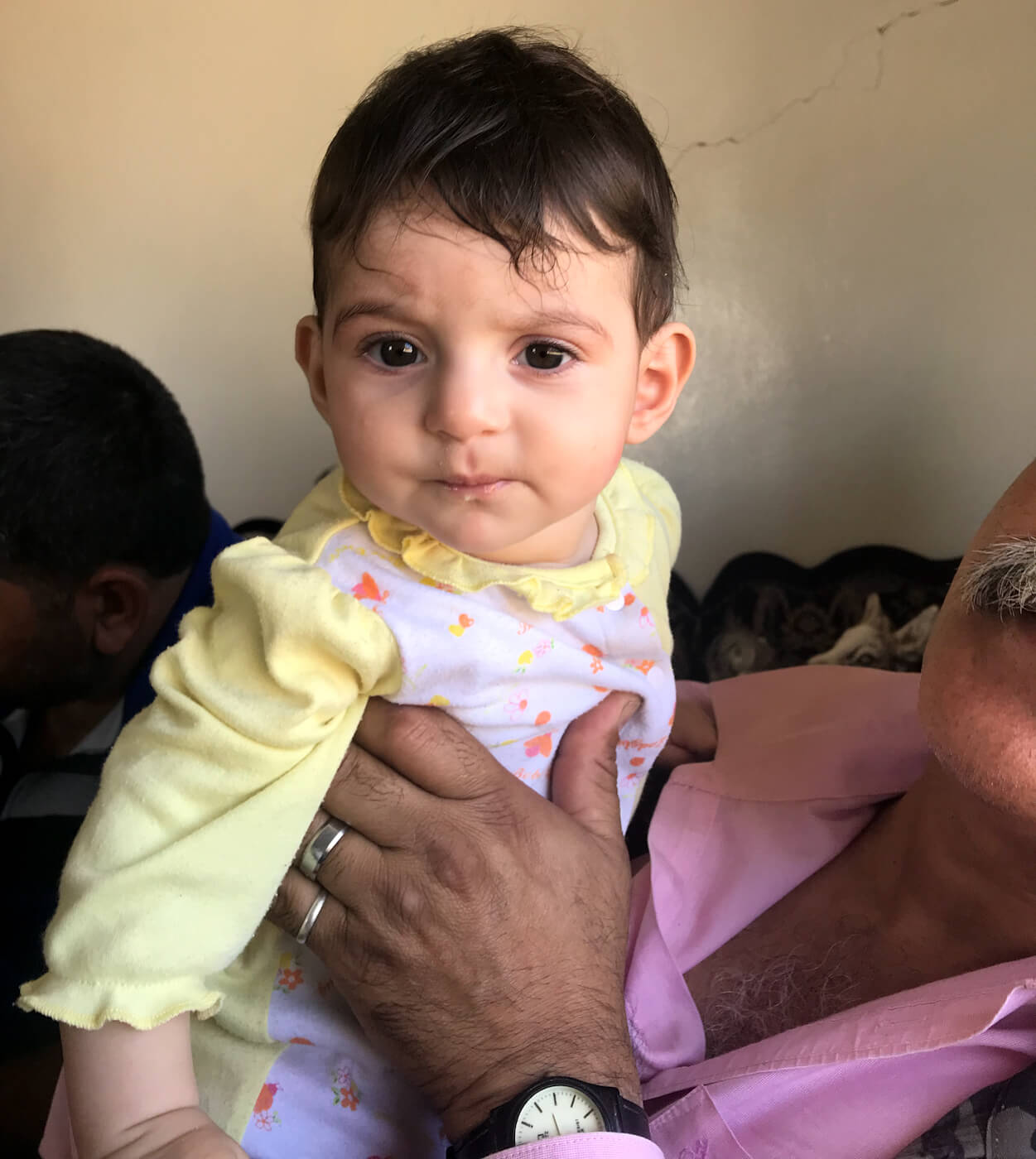
Six-month-old baby Ghala whose father was gunned down by ISIS terrorists 100 yards from Ziad Saab’s home. Photo | Vanessa Beeley
As we were eating breakfast with Ziad and his family, baby Ghala was brought into the room. Ghala is six months old; her father was gunned down by the ISIS fighters just a hundred yards from Ziad’s bullet-strafed home on July 25. Watching Ghala being held aloft by H. Saab, her gorgeous little face breaking into smiles, it was heartbreaking to comprehend the suffering and loss that so many children in Sweida and across Syria will have to grow up with as a result of this senseless violence.
Wissam Sliman, a Syrian who followed events in Sweida closely, described on Facebook the trauma of the ISIS attacks in the Sweida countryside:
Imagine that this were your village, or your neighborhood! Imagine that one of those were your house! Imagine that the same thing happened to you! Imagine that you lost a family member, or maybe two, or maybe more! Imagine that your mother, sister, daughter or son is still kidnapped and now in the hands of the worst terrorist group ever, which is ISIS!
And above all imagine that it didn’t mean anything to half of your brothers and sisters in humanity in this world, just because they are still sleeping, daydreaming and refusing to wake up! What hurts you is that if they did wake up seven years ago, you would have had many of your beloved ones around you now, but they didn’t, because they are still refusing to wake up!”
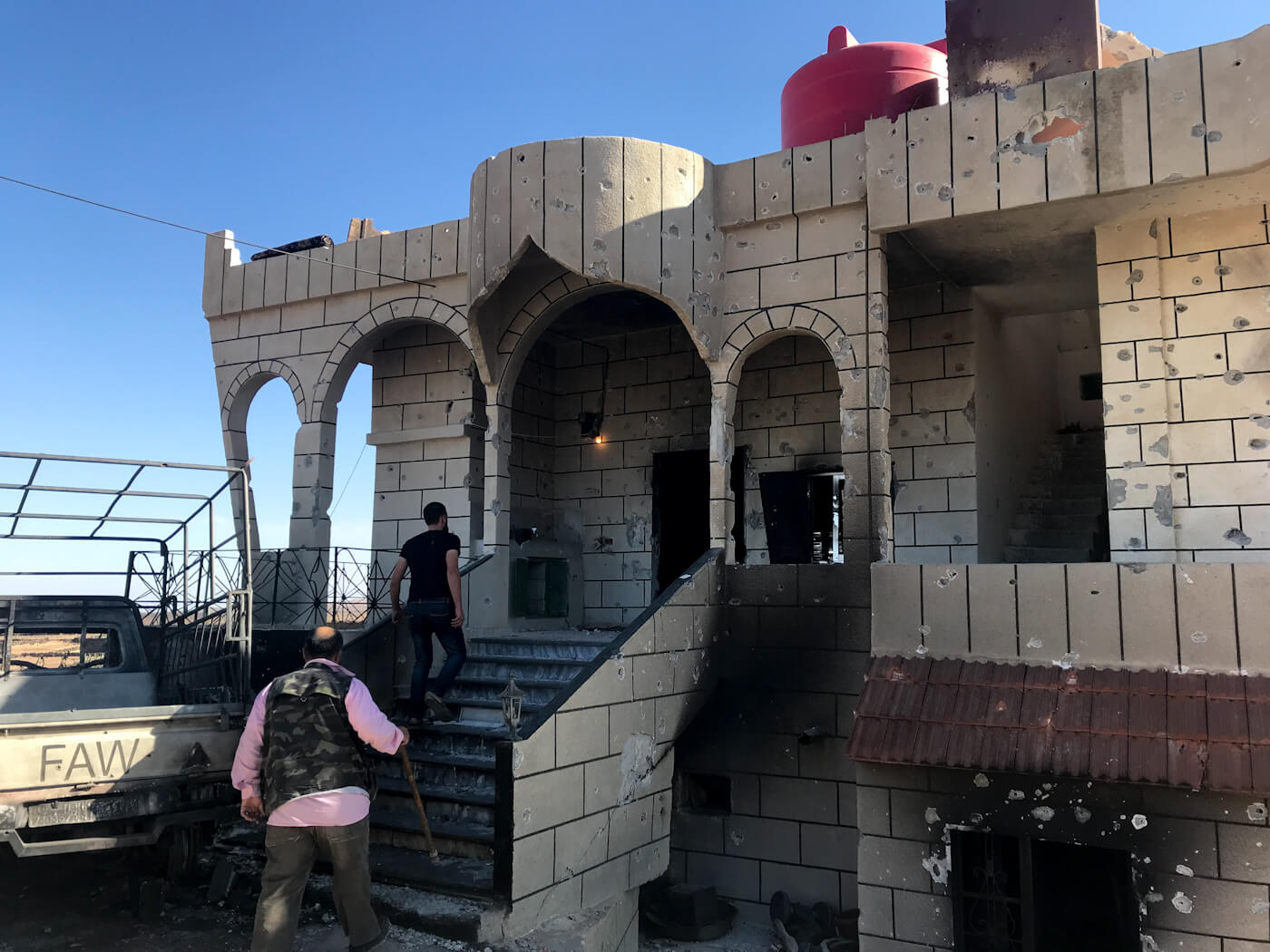
Shbeki: outside of a home taken over by ISIS for use as a sniper nest. Photo | Vanessa Beeley
In Shbeki, the next village I visited, the violence and bloodshed had intensified. Here, 60 civilians were massacred and 29, mostly women and children, were taken hostage by the fleeing ISIS gangs. I was told, during a visit to Shbeki in November, that only 12 men were available to defend the village early on in the ISIS attack but they managed to hold ISIS at bay until reinforcements arrived shortly after. At the entrance to the village was a burned out car embedded in the rock-strewn earth.
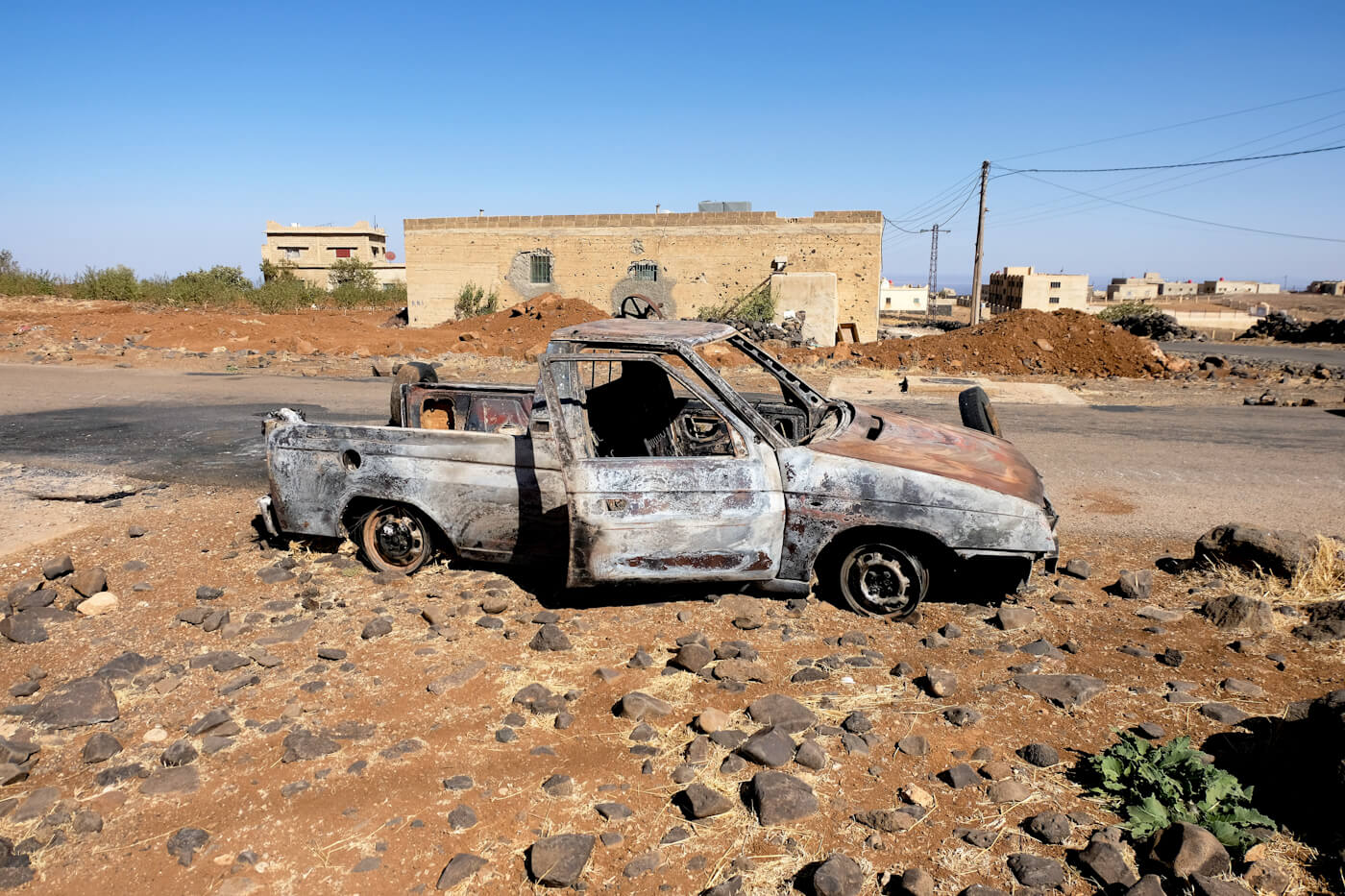
A burned out car at the entrance to Shbeki. Photo: | Vanessa Beeley
The car, a Skoda, had once belonged to Bahjat Atallah Saab who tried to rescue Zahi Jadallah Saab and his wife and son, Assem Zahi Saab, a law student. The entire car was targeted when they tried to flee the ISIS attack on Shbeki that began at 4 a.m. on 25th July 2018. The car came under attack by the ISIS snipers before being targeted by an RPG which turned the car into a furnace from which the occupants did not escape. Martyr Bahjat Saab was working as an Arabic language teacher.” ~ Vanessa Beeley, Sweida: A Bloody Massacre Barely Registered by Western Media as ISIS Slaughter Innocent Civilians in their Sleep.”
In Shbeki we spoke to Hazem, a third-year science research student at Damascus University, who had received news of the attack on his family at 4:40 a.m. on July 25, while he was staying in Sweida City. After a hazardous and circuitous journey to Shbeki, he entered the village at 5:30 a.m. in the midst of the fiercest crossfire between villagers and ISIS.
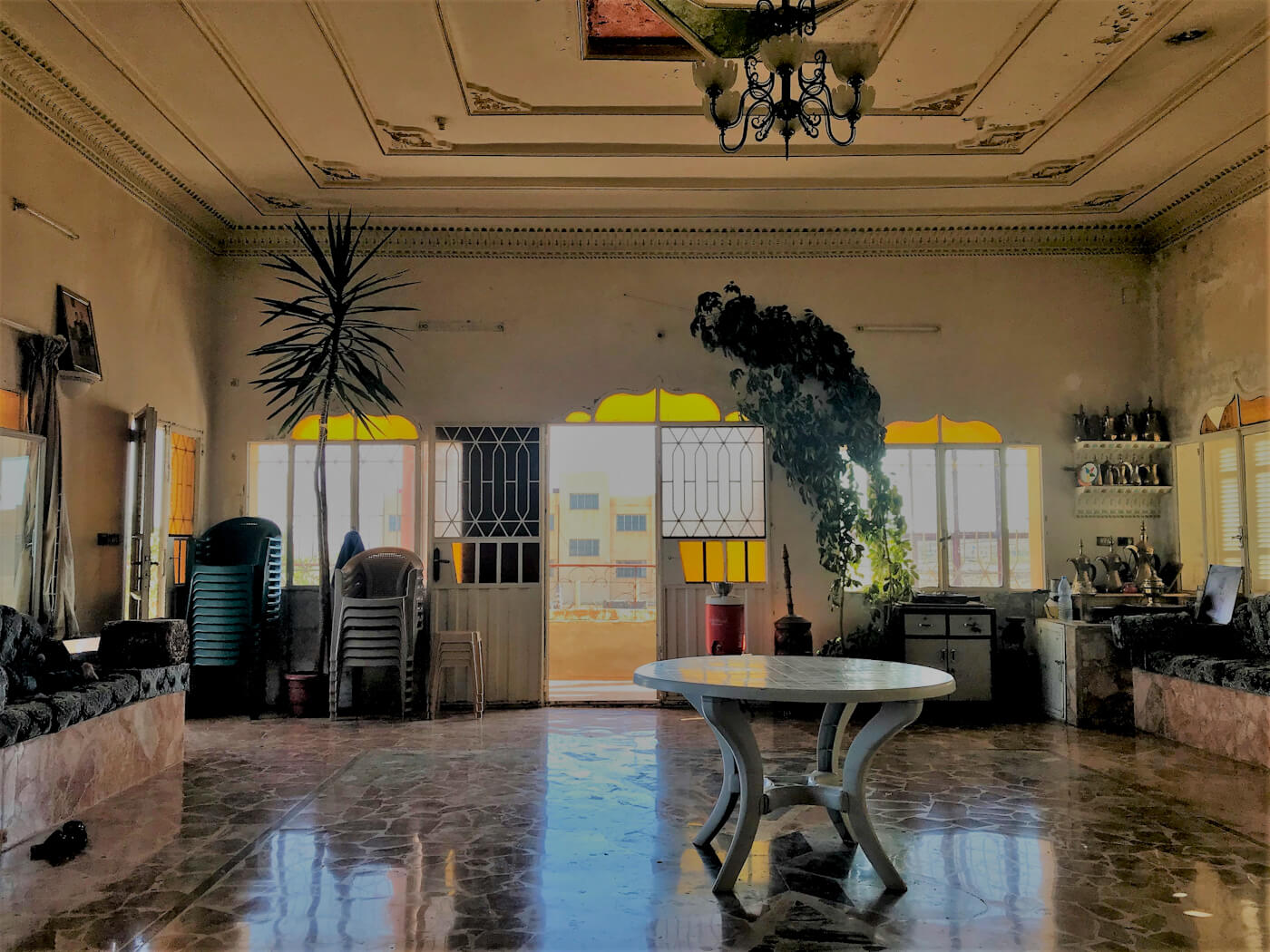
The Madafa, or meeting room, in Shbeki. Photo | Vanessa Beeley
All homes in Sweida have the traditional meeting room, the Madafa, which is always the most resplendent and light-filled room in any home. With the sun pouring through the glass onto the polished marble floors, I listened to Hazem as he recounted the events of that day. He told us that his family and other civilians were rounded up and taken to what is known as the “Bedouin House” at the outskirts of the village. The house faces in the direction of the eastern desert plains that divide Shbeki from the U.S.’ Al Tanf military base.
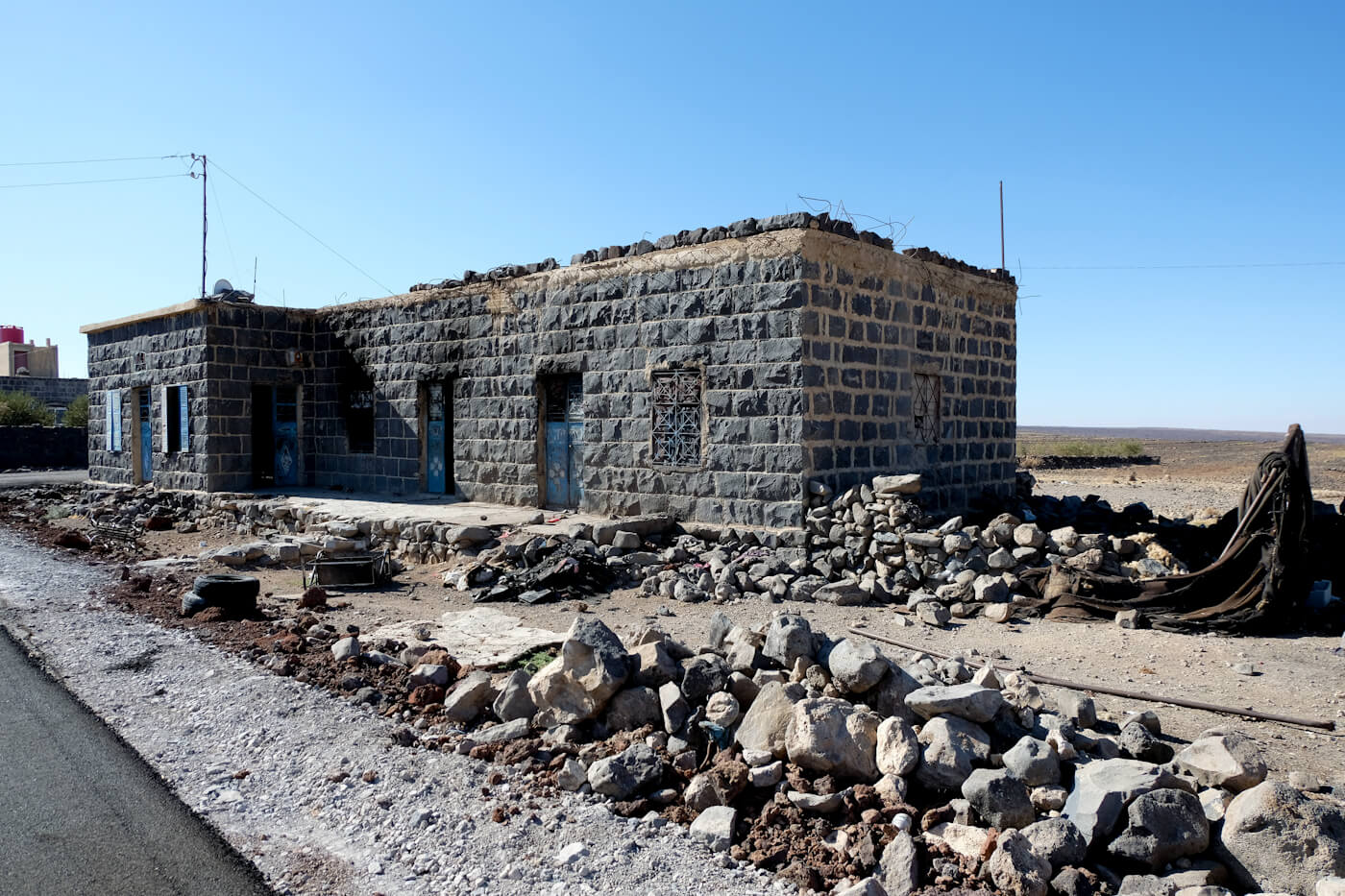
The “Bedouin” house where the men of the village captured by ISIS were executed. Photo | Vanessa Beeley
The ISIS terrorists took all the men outside and executed them in cold blood. Among them were Hazem’s father, brothers, cousin and neighbor. The women and children were then forced outside to see the bodies of their fathers, sons and husbands before they were taken hostage and force-marched towards Tilal Al-Safa. A few of those who had been kidnapped managed to evade their ISIS captors and returned to Shbeki, where they slept in an abandoned house just outside the village until dawn, when they were able to ascertain that the village was still under control of their friends and family. Among those who escaped were Hazem’s mother and sister-in-law. In total, 29 hostages were eventually abducted by ISIS mercenaries.
During the forced-march towards Tila Al-Safa, Hazem’s uncle’s wife, Ghosun Hasan Abo Ammar, had collapsed and had been unable to walk any further. The first group of ISIS fighters left her by the side of the road and refused permission for anyone to stay with her. Later, I was told that another team of ISIS terrorists had followed on behind and had executed her on the road. Her body was eventually retrieved, the next day, 6 km from the village.
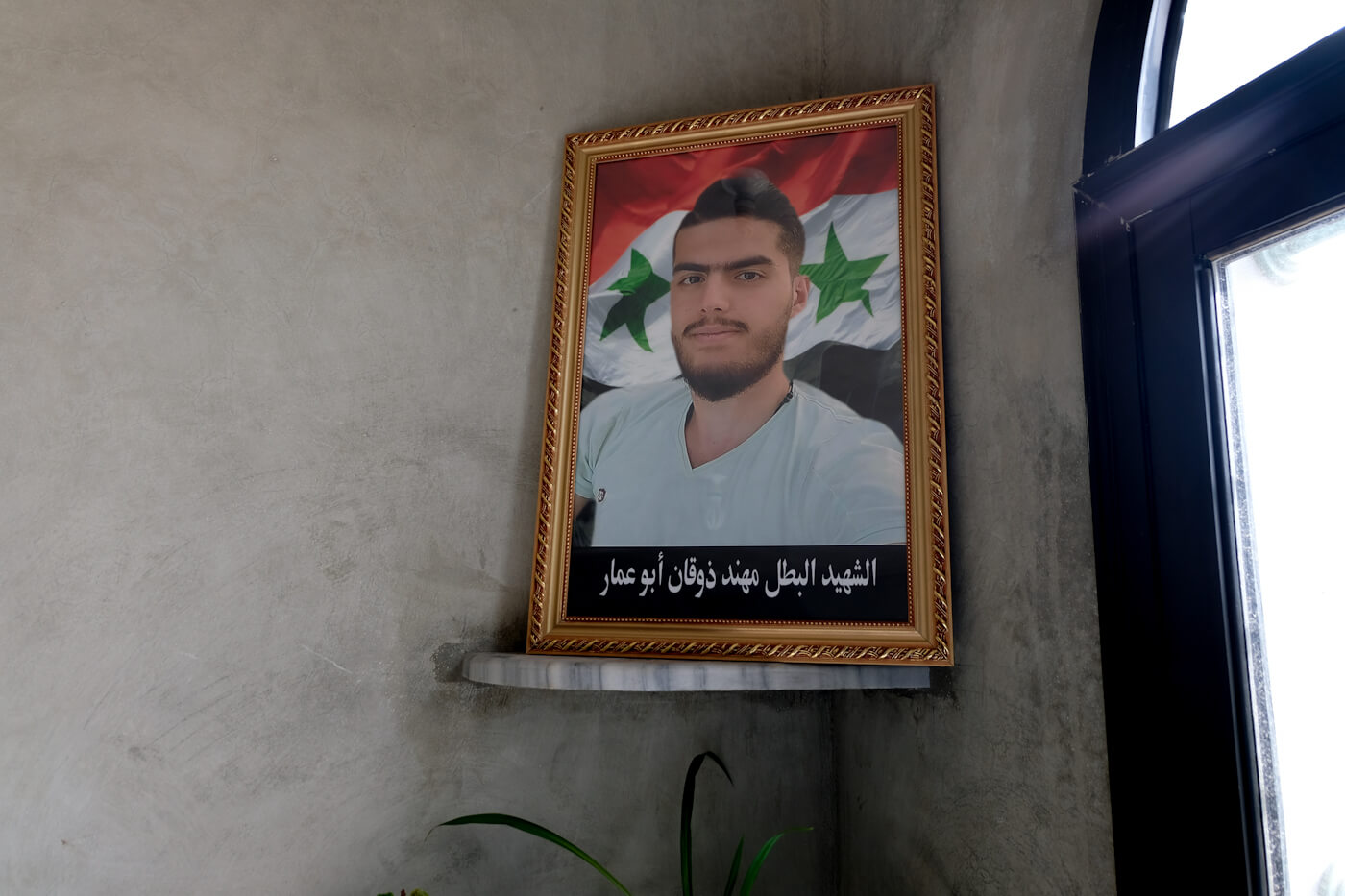
A photo of Mohannad Thokan Abo Ammar, beheaded by ISIS just eight days after the attack of 25th July, 2018. Photo | Vanessa Beeley
Eight days after the attack, ISIS executed one of the few young men in the group of hostages. Twenty-year-old university student Mohannad Thokan Abo Ammar was brutally beheaded by ISIS according to his family in Shbeki.
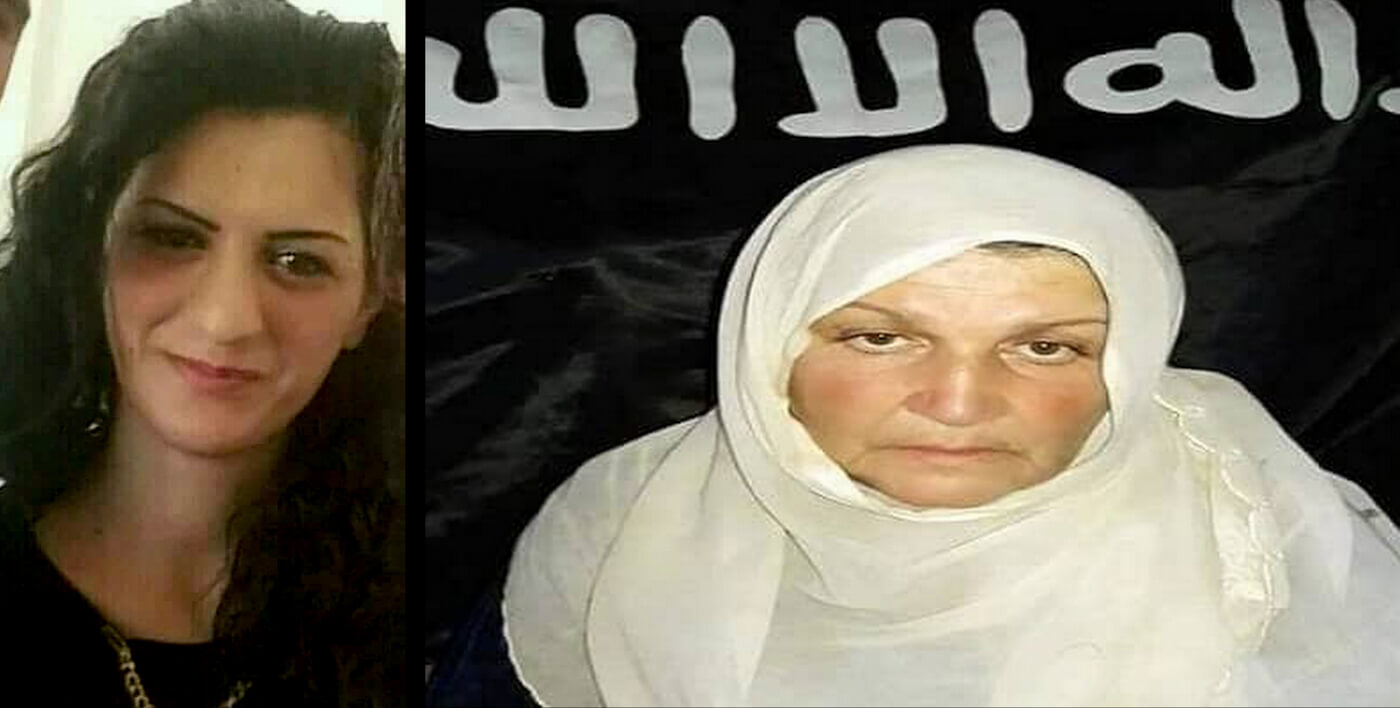
Left, Tharwat Fazel Abo Ammar, executed by ISIS on October 2, 2018. Right, Zahia Fawaz Al-Gebay, who died from health problems exacerbated by conditions hostages were forced to live in by their ISIS captors, on August 9, 2018. Photos | Courtesy of a Shbeki resident
On October 2, shortly after I left Syria, ISIS executed Tharwat Fazel Abo Ammar. They shot her in the head and filmed the gruesome ending of a young mother’s life to taunt the Sweida civilians and to warn them of further executions if any attempt was made by the SAA to pursue ISIS. Threats were issued by ISIS to conduct further executions if the SAA did not throttle back its military campaign to eradicate ISIS in the Yarmouk Basin, vindicating a theory by H. Saab that this was one of ISIS’ motives behind the attack.
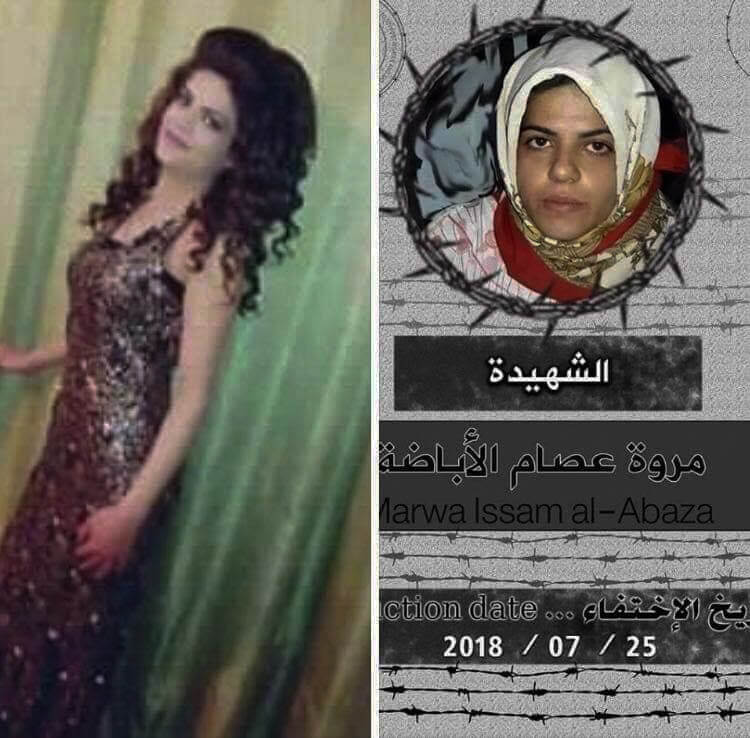
Marwa Essam Al-Abazah, the third female hostage to be executed by ISIS, just five months after her marriage to Majdee Abo Ammar. Photo | Courtesy of a Shbeki resident
Marwa Essam Al-Abazah was the wife of Majdee Abo Ammar, they had married just five months prior. Al-Abazah was the second female hostage to be executed by ISIS.
Before we left Shbeki in September, Hazem asked if it were possible to record a video message about the remaining kidnap victims, almost entirely women and children:
The SAA operation to liberate Sweida
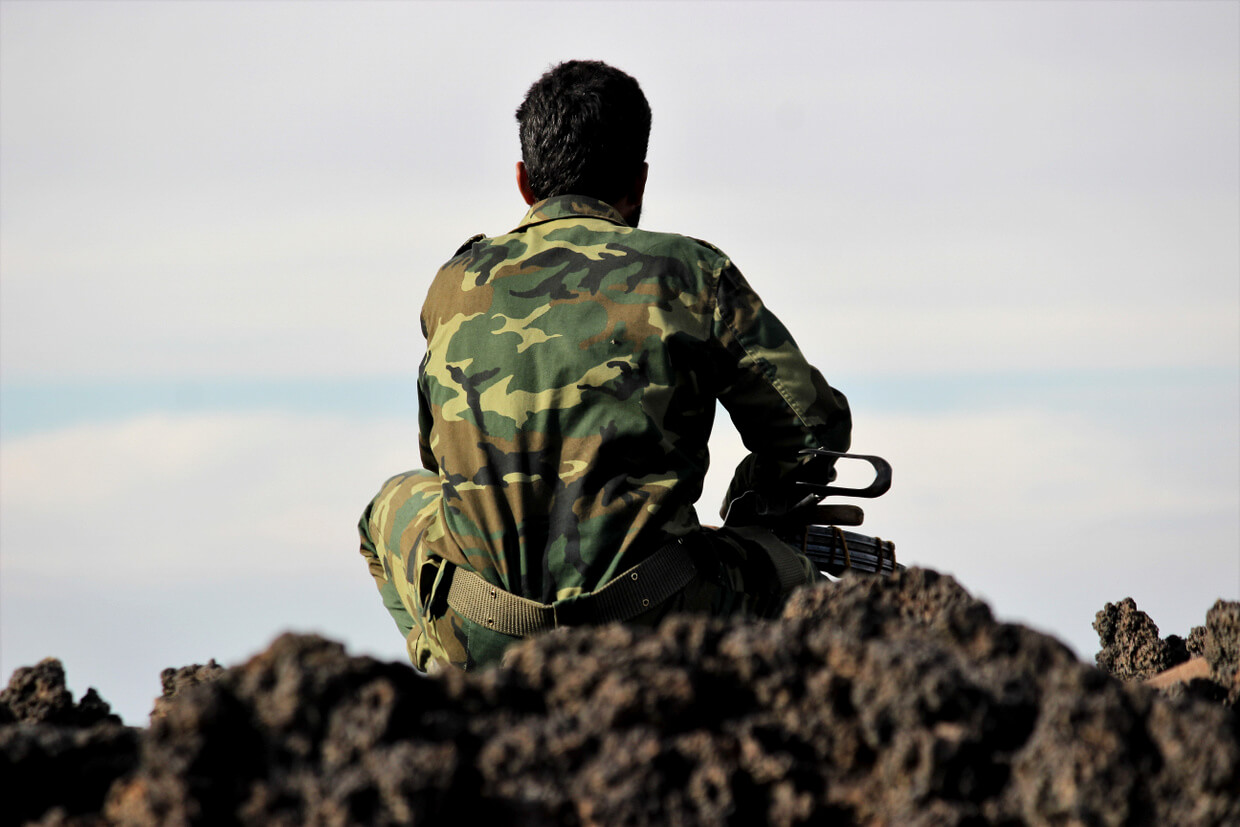
An SAA soldier surveys the unforgiving landscape of Tilal Al-Safa, northeast of Sweida. Photo | Vanessa Beeley
Elijah J. Magnier, Middle East analyst and journalist, described how ISIS terrorists benefited from the U.S. presence in the Al Tanf military base:
ISIS benefited from the U.S. safety [perimeter] around its military base at al-Tanaf, preventing Syrian and Iraqi armies from breaking into this [perimeter] to pursue ISIS when needed. ISIS took advantage of the U.S. measures and used the area to cross for the north where there is the bulk of its forces.”
Almost immediately after ISIS carried out the attacks in Sweida City and the eastern villages, the Syrian Arab Army (SAA) ramped up its operations to finally defeat ISIS in the region and to liberate the Sweida kidnap victims, who had been taken deep into ISIS-controlled territory in the volcanic and treacherous terrain of Tilal Al-Safa.
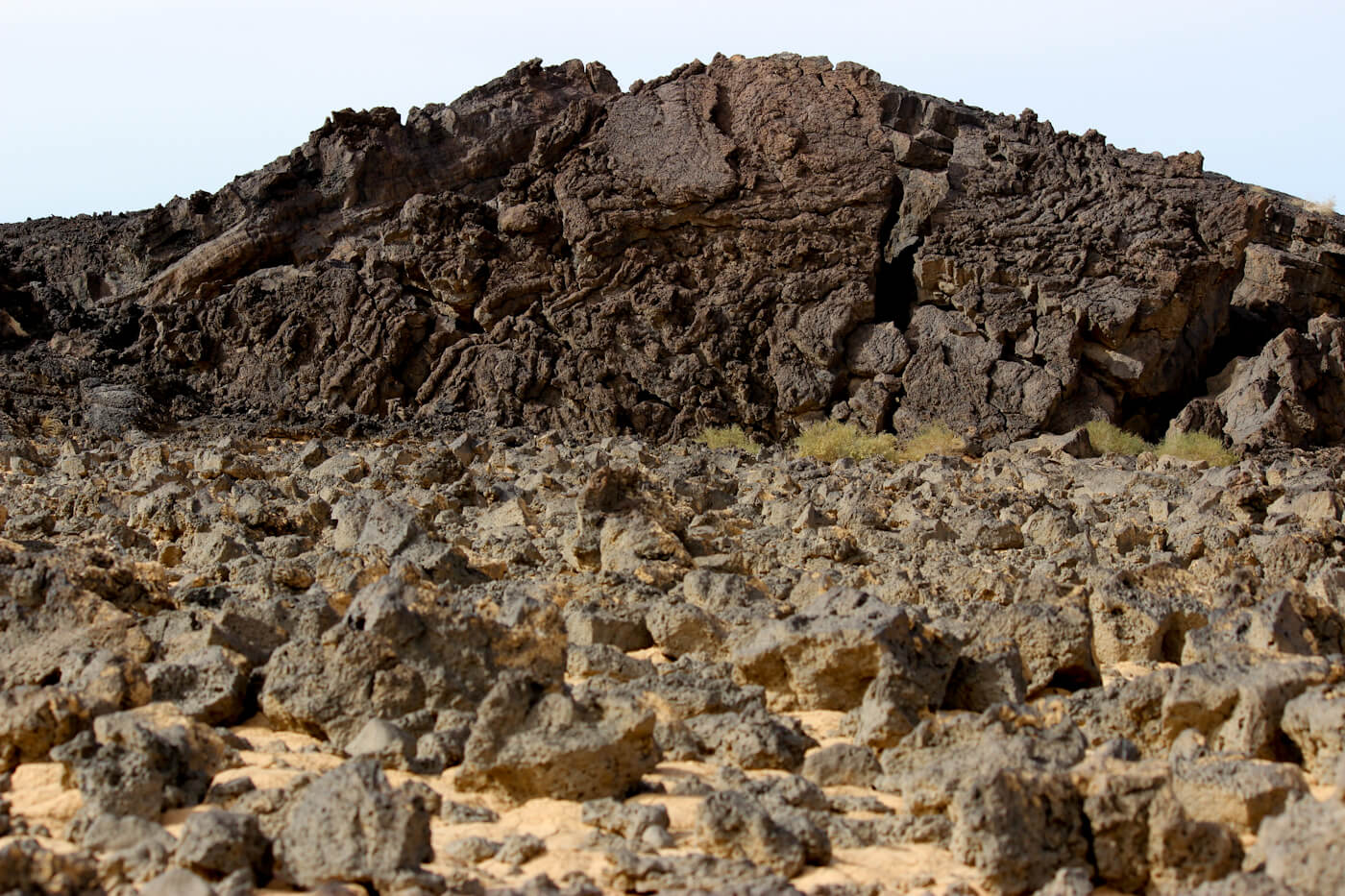
The treacherous terrain of the Badiya (desert) at Tilal Al Safa – an ISIS stronghold to the east of Sweida. Photo | Vanessa Beeley
On October 14, 2018, Syrian Arab News Agency (SANA) reported that units of the SAA, in cooperation with allied forces, were continuing to “tighten the noose” around ISIS terrorists in the depths of the rocky escarpments and cliffs of Tilal Al-Safa, the “last stronghold for ISIS in the Sweida eastern Badiya [desert].” The SAA was inexorably advancing, uncovering stockpiles of U.S.- and EU-supplied weapons and ammunition left behind by the retreating terrorists.
On November 27, 2018, a video was released by a Russian Media outlet, Rusvesna, showing SAA soldiers uncovering arms caches in Tilal Al-Safa. SouthFront, an independent media outlet following the Syrian conflict very closely picked up on these videos and reported on them:
The weapons caches contained a U.S.-made TOW anti-tank guided missile (ATGM), three Bulgarian-made Fagot ATGMs, two Soviet-made RPG-22 anti-tank rockets and a Yugoslav-made M79 Osa anti-tank weapon along with five rounds.”
Earlier in November, images taken from the mobile phone of a captured ISIS fighter had shown that the “terrorist group was using U.S.-made assault rifles and a Chinese-made man-portable air-defense (MANPAD) system, FN-6, which had been reportedly supplied with help from the U.S. and Qatar to several Free Syrian Army (FSA) groups in Syria.” The supply pipeline was the failed U.S. “train and equip” program authorized by former U.S. President Barack Obama in 2014 and halted by President Donald Trump in 2017.
The captured ISIS fighters admitted that they had been receiving assistance and weapons directly from the U.S. base in Al Tanf. According to a South Front report, captured ISIS member Abu Abdullah Mayadin told Syrian reporters on November 9:
We received supplies from the U.S. base in al-Tanf through Abu Audi, his brother Saeed and Abu Ali al-Buri [al-Badui]; he is a member of ISIS, he provided us with vehicles and 23mm machineguns.”
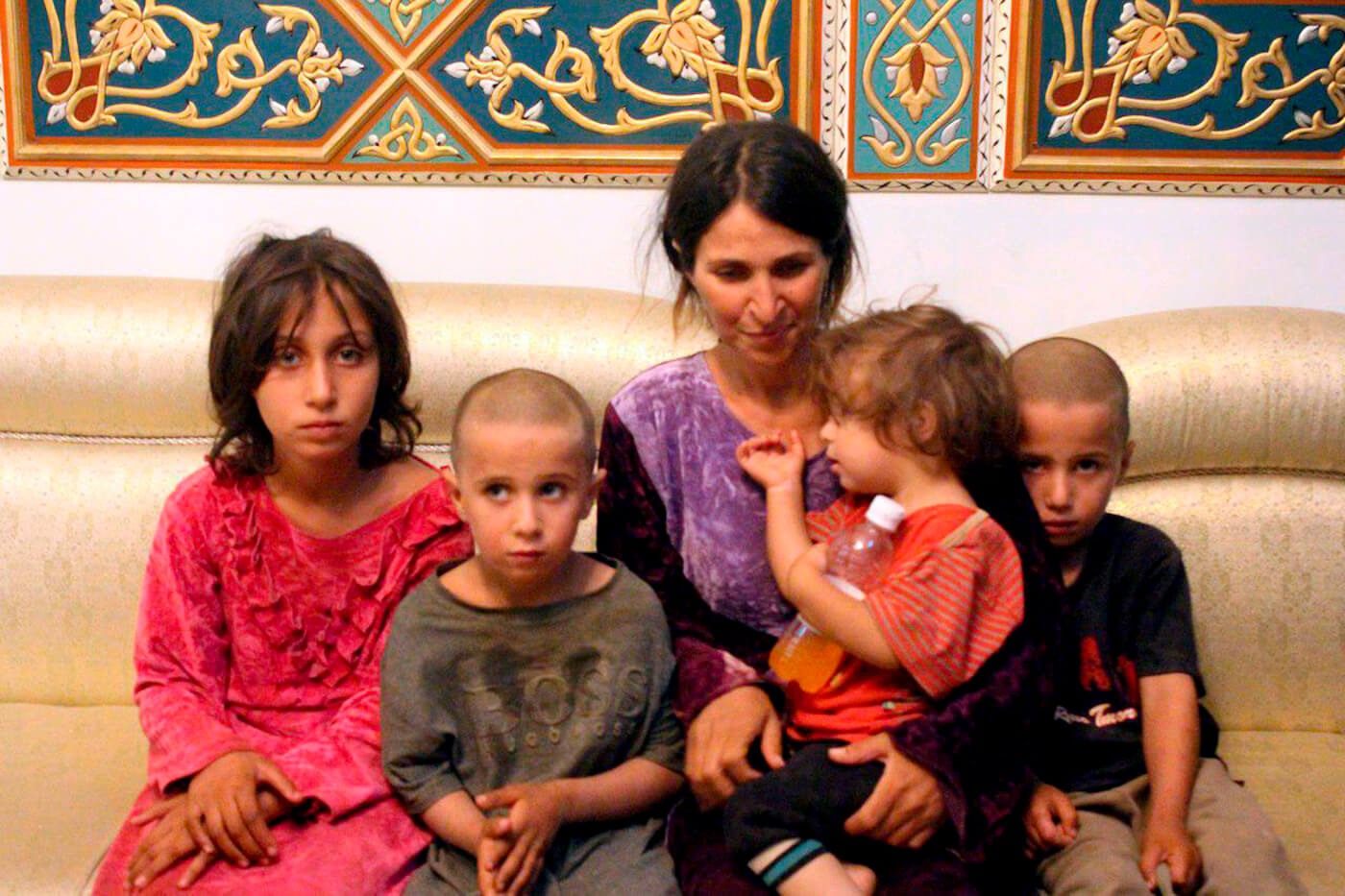
Abeer Shalgheen and her four children after being released by ISIS. Nov. 8, 2018. SANA | AP
On October 20, following negotiations between the Syrian government and ISIS terrorists, six of the hostages were released. Among them were four children — Ya’arub Jba’ai, Mulham Jiba’ai, Ghaida Jba’ai and Amwaj Jba’ai — and two women — Abeer Shaglin and Rasmyia Abu Ammar — according to the SANA report.
While certain corporate media outlets and “opposition” figures like Lebanese Druze leader Walid Jumblatt appeared to exploit the post-ISIS-attack confusion to attempt to drive a wedge between the Druze community and the Syrian government, all civilians I spoke to expressed gratitude for the way in which Syrian President Bashar Al Assad involved himself in the negotiations for the release of the hostages and for the government’s near-daily contact with community leaders to follow up on the progress of the talks.
Their admiration and respect extends to the SAA, which fought a long and arduous campaign to cleanse ISIS from the southern region.
The news everyone had been waiting for
Watch what one of the young girls from #Sweida who were kidnapped by #ISIS said after she and the others were freed by the Syrian army. The expression on her father’s face when she said she feared she would never see him again
#Syria Video via @Marwa__Osman pic.twitter.com/YbFFEajE4E
— Walid (@walid970721) November 9, 2018
On November 8, 2018, the news finally broke that the SAA had succeeded in liberating the Sweida hostages and had defeated ISIS in Tilal Al-Safa. After what was described by field commanders as an intricate and complex rescue operation, complicated by the ISIS fighters constantly moving the hostages to avoid detection, the surviving hostages returned to emotional and jubilant scenes in Shbeki on November 9.
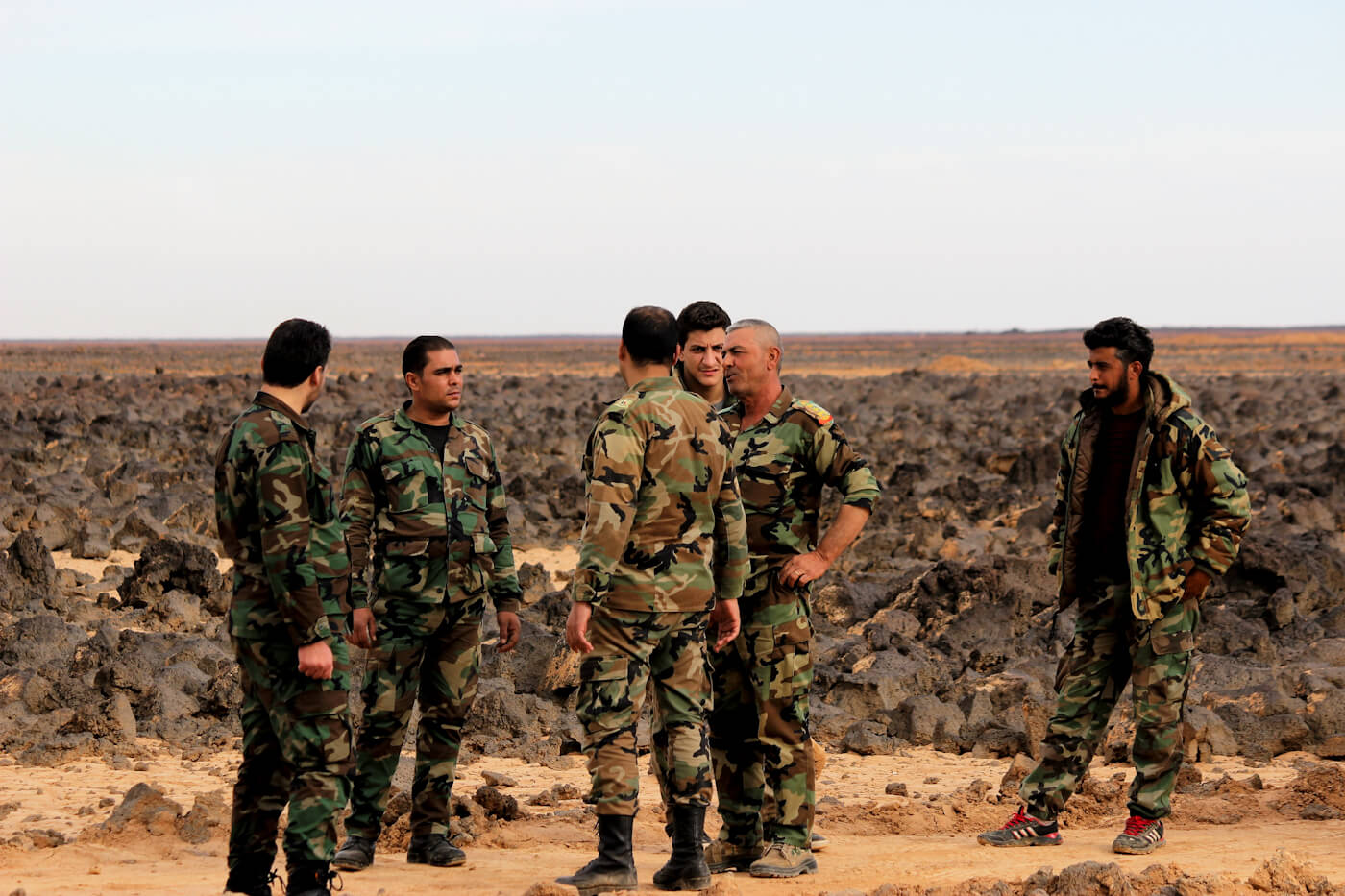
SAA soldiers in the desert region of Tilal Al-Safa following the liberation of hostages and defeat of ISIS. Photo | Vanessa Beeley
On November 13, President Assad himself received the liberated women and children and their families. The president stated at the time:
The steadfastness of the abductees and their families, their strength and patience during the time of abduction from one side, and the determination of the army heroes ,some of them have sacrificed their soul to liberate the abductees — women and children — from the other side, will be a lesson in patriotism and national act. The State has put the mission of searching about each abductee on top of its priorities to liberate him or her whatever the price was, and it has put all its capabilities to achieve this mission”
A bloodbath ignored
While Human Rights Watch (HRW) described ISIS’ taking of hostages in Sweida as a “war crime,” outrage from the “international community” was muted, to say the least. An HRW report on the incident failed to fully describe the atrocities committed by ISIS in Sweida on the 25th of July. In fact, at the end of the report, HRW denounced the summary executions of two of the ISIS hostage-takers as a “war crime” and concluded — quoting HRW’s deputy Middle East director, Lama Fakih:
“Mob justice and revenge are no answer to ISIS atrocities,’ said Fakih. ‘Without a commitment to justice for violations by all sides, it will be difficult to deter more abuses.’” (emphasis added).
Among the international community, Russia’s foreign minister was one of the very few that condemned the hideous slaughter of civilians in Sweida. The silence from other world leaders and media outlets was an appalling example of their priorities in Syria, which clearly do not include the Syrian people.
UN Secretary-General António Guterres did unequivocally express horror at the ISIS attacks on the same day that they happened, but later statements by UN agencies distorted the view on who must take responsibility.
The Office of the UN High Commissioner for Human Rights placed blame on the Syrian government, claiming that groups of ISIS terrorists included many “who were recently evacuated and relocated from the Palestinian Yarmouk Refugee Camp, Hajar Al Aswad and Al Tadamon areas of Southern Damascus as part of a [Syrian] government reconciliation agreement,” according to OHCHR spokeswoman Ravina Shamdasani.
Shamdasani went on to declare that the “government of Syria has a duty to take action to prevent violent acts that may endanger the lives and well-being of civilians — including by not placing armed groups such as ISIS in their proximity.”
The Syrian government has been fighting off a terrorist invasion of their country for eight years — an invasion financed, equipped and armed by the U.S. coalition and its allies in Turkey, Jordan, Saudi Arabia, Qatar and Israel. The “placing of armed groups in the proximity of civilians” is entirely the responsibility of the U.S. and its allies and with its statement, the UN demonstrated the extent to which it acts as an outpost for U.S. Empire, supporting U.S. hegemony and globalism in the region.
Alison Banville of BS News, an independent media outlet, emailed Jon Snow of the U.K.’s Channel 4 to ask why it had not covered the massacre in Sweida. The email conversation went as follows:
Jon Snow: Alison, I’m pretty sure we did report it on Channel 4 News… I will try to track it down… thanks for drawing my attention.
Alison Banville: Further to your reply to me below regarding the horrific Sweida massacre in Syria in which you said you ‘think’ Channel 4 News covered it but you’ll check, there still appears to be nothing about it on the Channel 4 News website.
Did the programme really not cover this atrocity? And if not, the question must be asked, why
Below is journalist Vanessa Beeley’s report from on the ground in the villages attacked by ISIS and the shocking testimony of witnesses. Isn’t this what Channel 4 News should have done if journalism is what you do? These are people begging for their voices to be heard. How can you justify not reporting this?
Jon Snow: Like everyone else we are very stretched in Syria… We are now very dependent upon ‘stringers.’ We have never been able to verify what happened… as in so many other cases… and we are reluctant to go beyond what we can verify for ourselves… I’m sorry if this displeases you… but the fake news, unsupported claims do Syria’s agony and loss no favours. (emphasis added)
Not only does Snow appear to be suggesting that the Sweida massacre is “fake news,” it must be noted that the lack of anyone on the ground did not stop Channel 4 from producing “rebel”-biased reports based on evidence produced by the U.K. Foreign and Commonwealth Office (FCO) propaganda construct, the White Helmets, for example. The simple fact is that the Sweida massacre did not fulfill the requirements of the U.K. FCO to criminalize the Syrian government and its allies while maintaining the myth of a “war on terror,” aka ISIS, in Syria. That is why Channel 4 did not report on this crime against humanity: it was the wrong “humanity.”
The homecoming: Meeting kidnap victims after liberation
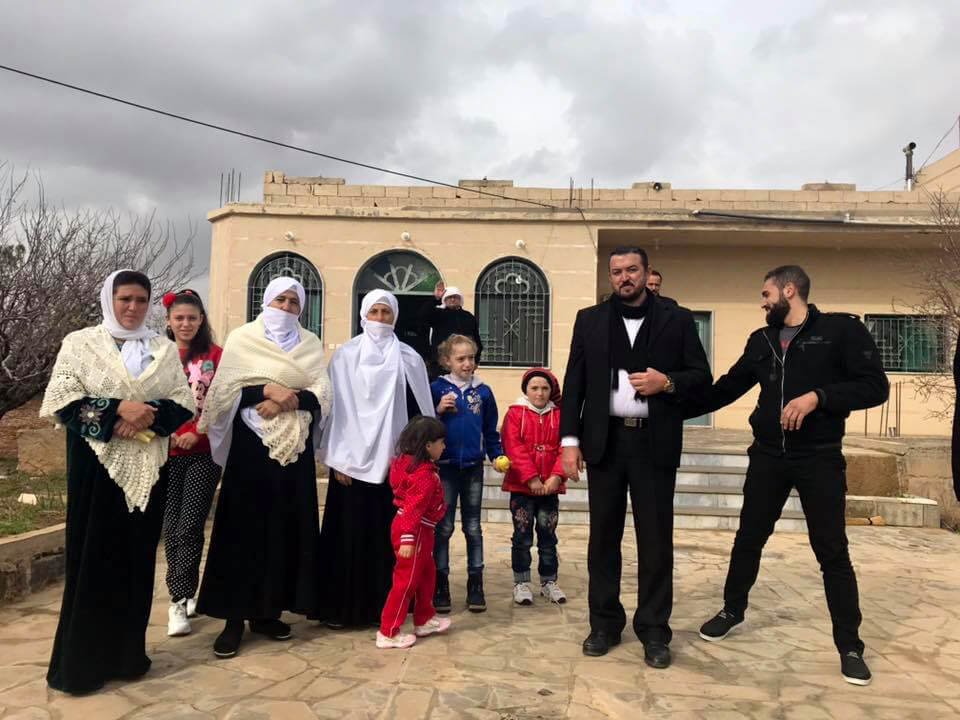
In Shbeki, meeting with the liberated ISIS hostages returning to “normal” life with their families. Photo | Vanessa Beeley
Towards the end of November, I headed back to Shbeki to meet with the liberated hostages and their families. It was a cold and foggy day but the familiar warmth of the welcome I received dispelled any gloominess that might otherwise have pervaded the meeting, with the kidnap victims clearly reliving the trauma of the three months they had spent at the mercy of their ISIS captors.
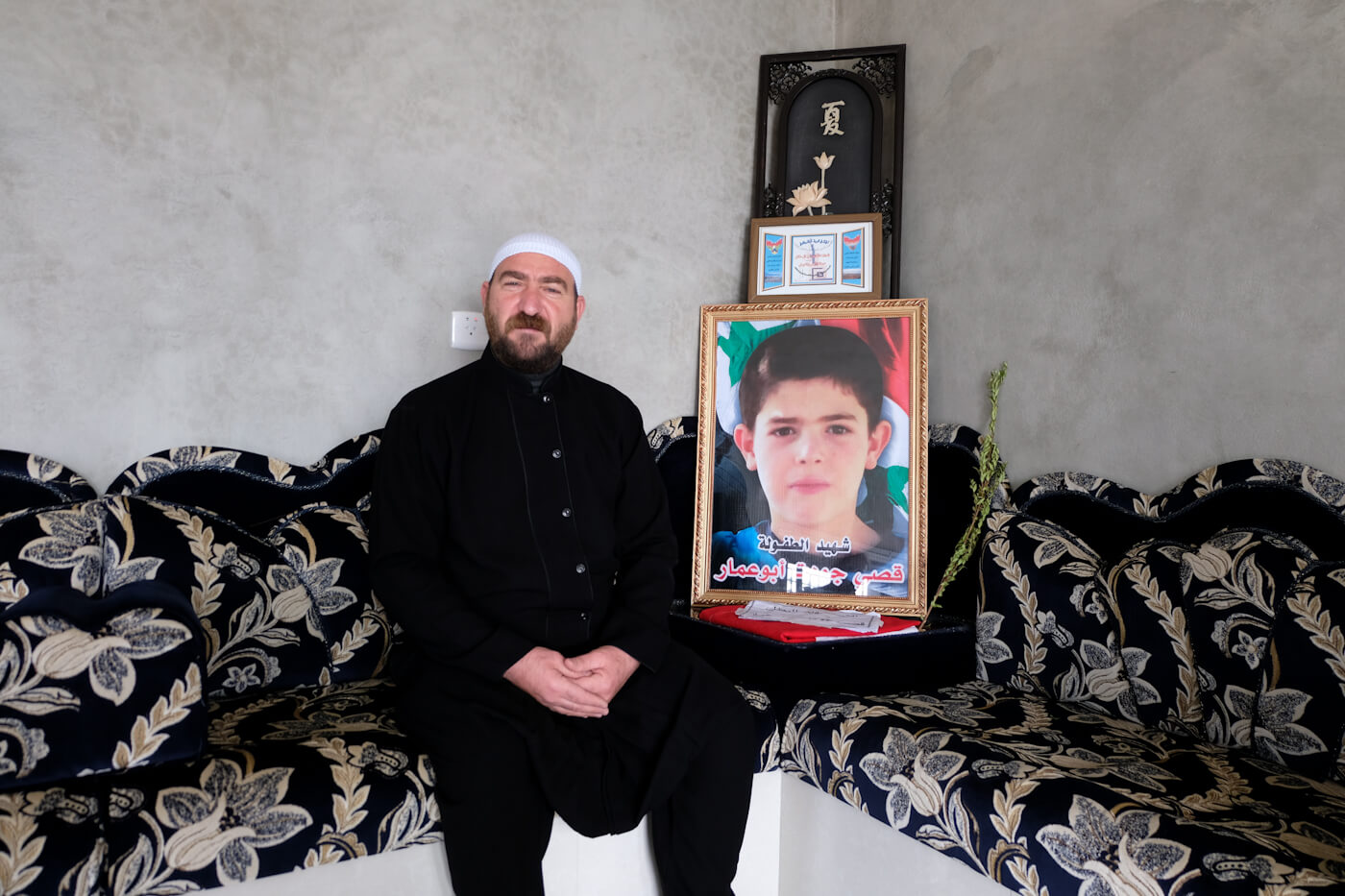
Jawdat Abo Ammar next to the photo of his martyred son, Qussai, fatally injured during the SAA rescue operation in Tilal Al-Safa. Photo | Vanessa Beeley
Sadly during the SAA rescue mission, two young boys among the hostages had been fatally injured, 10-year-old Raafat Abo Ammar and 13-year-old Qussai Abo Ammar. The first person to speak to me about this loss was the father of Qussai, Jawdat Hnidi Abo Ammar, whose wife and daughter Shahed were also among the ISIS hostages along with Qussai:
At the beginning, when we received the liberation news, they called us and told us that the abductees were liberated. In fact, it was a big joy, an indescribable feeling, this was what we have been waiting for so impatiently. Unfortunately the joy was not complete. They told us at the beginning that Qussai and Raafat were injured, we felt something… like a burn in the heart. About 7 o’clock they told us that Qussai and Raafat were martyred, that ripped out our hearts.”
Jawdat sat next to the photo of his son, Qussai, a proud and dignified man but visibly shaken by the events of the last four months. He went on to describe how President Assad had made the liberation of the abductees a priority.
A great thank-you to Mr. President Bashar al-Assad, may he live long, because since the beginning of the attack on our region he sent the minister to us and contacted us — and it was one of his priorities to liberate the abductees. We felt that ourselves on the day when we met him.”
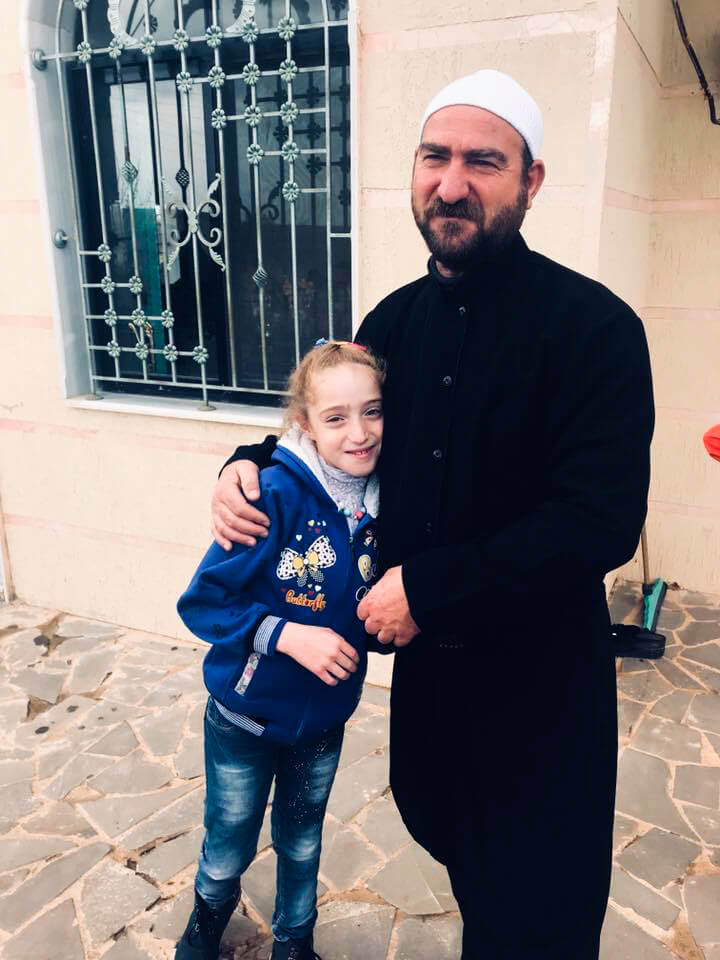
Jawdat with his daughter Shahed who was also among the liberated hostages. Photo | Vanessa Beeley
Jawdat emphatically praised the role of the SAA in the liberation campaign and expressed the love and respect that the majority of Syrians feel for the SAA, whose soldiers are the Syrian people:
A great thank-you to the Syrian Arab Army, protectors of the country, protectors of the land and our honor. Since the beginning of the crisis and for eight years they have been in the midst of a war. Almost all the colonial countries and the Arab countries — in general — joined together against Syria. So they [SAA] deserve a big thank-you and the credit is theirs because they returned the joy to our hearts.”
Jawdat addressed the media and Western government role in dehumanizing the majority of the Syrian people who support their government, their president and army:
Our call is to the major countries — I wish they possessed a shred of humanity so that they could treat people as human beings and not only as numbers. What sin did this child commit to be kidnapped from his house? Or that innocent woman who was sleeping in her home when they [ISIS] came and kidnapped her? I appeal to them to be humane, to feel for humans. God created all of us as humans — deal with us morally. Morals must take priority, even in war.”
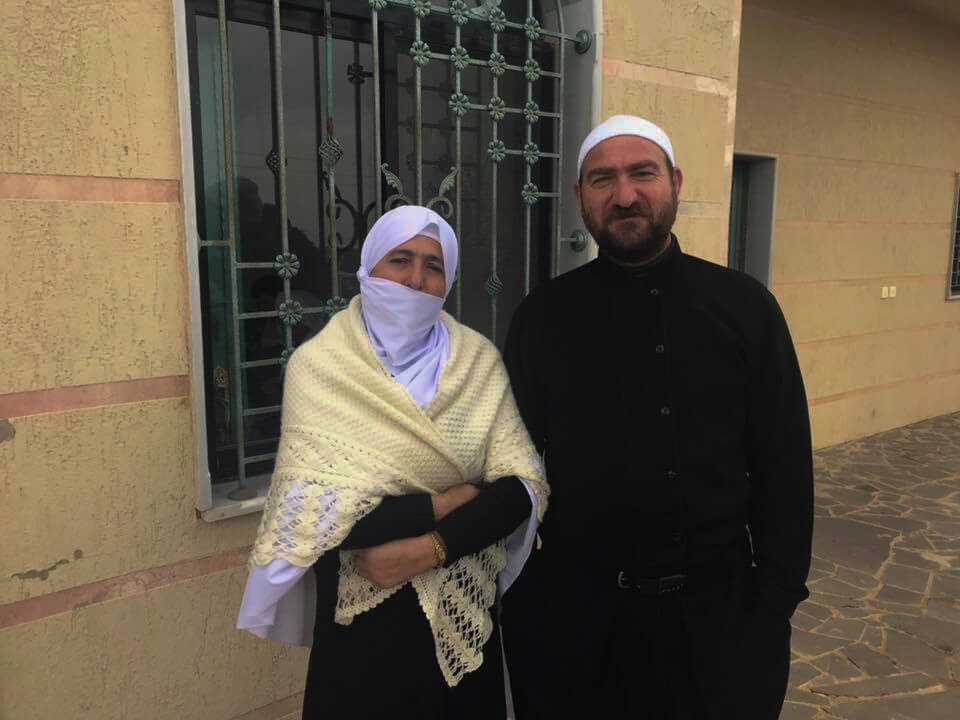
Jawdat with his wife, Fadia Badi Abu Ammar, also among the liberated hostages. Photo | Vanessa Beeley
Jawdat explained to me that many of the men of the village had been working in the Gulf states when the attack took place. It was five days before they could return home to the tragedy that awaited them. Jawdat’s brother’s family were also among the kidnap victims. Jawdat’s other son, Qais, had managed to escape his ISIS captors early on in the abduction and had returned safely home.
Jawdat also voiced the familiar anger over who was really behind the ISIS invasion of their homes and the mass murder of their families:
The West created these ISIS gangs that have no religion, know nothing about humanity and don’t possess a shred of morals, and backed them with money and weapons, for what? We stand beside our army and beside Mr. President and urge them to wipe the terrorism from the whole land of Syria, and to liberate us from the abomination of terrorism.”
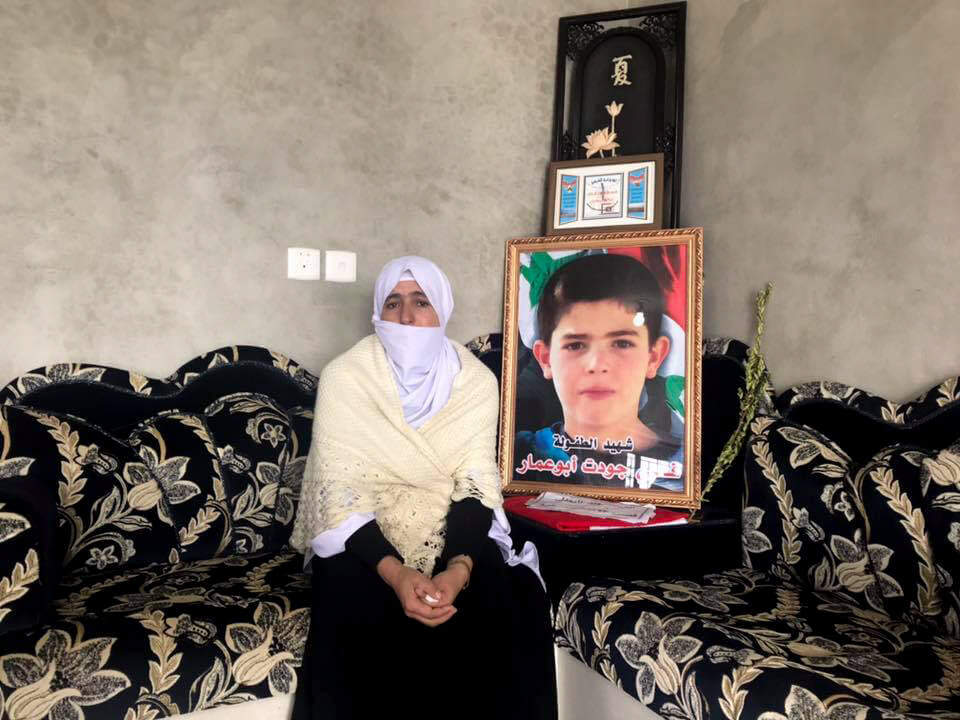
Fadia Badi Abo Ammar, wife of Jawdat and mother of Qussai. Photo | Vanessa Beeley
Fadia’s testimony was an emotional journey through loss and trauma. She sat closer to the photo of Qussai and wept many times as she talked to me about the three months of ISIS brutality and abuse they endured.
When the attack began, Fadia had gathered her three children around her — Shahed, Qussai and Qais. They had stayed hidden in their home but ISIS knocked on their door demanding that the men be sent outside. Fadia had remained silent but she described how shots were fired at the house to drive them out. Fadia told me how the terrorists would go to a house and drag civilians onto the street, these civilians would be forced, at gunpoint, to knock at a neighbors house to entice them outside.
Fadia explained how this ruse was used to deceive them also:
When my brother-in-law’s wife came and I heard her voice ‘open the door, don’t be afraid, we want to go to the neighborhood’ and things like that. Of course, I didn’t open the door immediately; I waited because I didn’t want to open the door even if it became safe I didn’t want to go out of the house. My oldest son said ‘No mum, this is my uncle’s wife, probably everything is fine, we want to go to the neighborhood.’ So we opened the door and they [ISIS] said, ‘We want to take you to the school for about an hour then we will bring you back because we want to comb the houses.’”
Fadia was subsequently used by ISIS to persuade other family members to join their group as ISIS moved them towards an agricultural unit. Their mobile phones were taken from them. Initially, the ISIS fighters were claiming they would be held for a short time and then allowed to return home, but the mood changed when it was decided that Fadia and the others would be more useful as hostages, as bargaining chips in negotiations with the SAA and the Syrian government. They were moved out of the village towards Tilal Al-Safa:
They took us to the east of the village for about 15 minutes and after that they took us down to the valleys. We walked for about 10 or 11 hours without water, food or anything, and there were kids, a pregnant woman and old women with us.”
Haltingly, Fadia described the abuse hurled at them by the ISIS fighters: “Of course, they used bad words, ‘you are Kuffar [disbelievers], you are impure’ and things like that.”
Some of the hostages were isolated early on: “They isolated the Martyr Mohannad, the Martyr Qussai, Yaarub and Rajwan, they put them in a tent next to us. They took them, blindfolded their eyes and put them in a tent next to us.”
Fadia described how they were moved from place to place, staying in the first cave for six days before moving on to a different area where they were forced to shelter in a craggy, narrow ravine in the volcanic landscape. They were fed and given water intermittently, the first water they were given “tasted like diesel fuel.” While the adults, mostly women, were subjected to verbal humiliation, the children received beatings and physical abuse:
We went through all kinds of torment; we were starved and deprived of water, they humiliated the kids in front of us and beat them. For us, we were only humiliated by words — ‘you are defectors, you are impure’ — but the kids, they beat them and humiliated them. When they brought water for us we used to send the kids to bring water, there were children with us, one of them was a two-and-a-half-year old baby girl. The kids would go and ask for water, then they would be beaten and come back — Yaarub, Rajwan and Qussai.”
As the SAA advanced, ISIS would move the hostages deeper into the desert. At one point, Fadia told me they were marching for six days straight. The hostages were given one glass of water per day to be shared among three people and two dates for each hostage. For three days, they were given nothing. When the gunfire drew closer, the terrorists would taunt the children and the mothers by saying they would take the children towards the SAA positions and dig a grave for them so when they were shot, they would fall into the grave.
Fadia remembered the day of their liberation. Qussai had gone to get some water for them in the direction of the fierce clashes between ISIS and the SAA that could be heard close by. Most of the hostages had taken shelter in one of the ISIS trucks but Fadia had crept under the truck and was sitting on the ground when Qussai returned with the water. She testified:
In these moments Qussai and Raafat got injured, I came after hearing my sister shouting ‘Woe to you . . . O Qussai . . . come and see your son.’ I got into the truck and saw that my dear was injured but — thank God — he was still alive and fully conscious. He admonished me ‘Mum, why hadn’t you gotten into the car? Why are you still down there?’ and ‘Mum, what happened to my eye?’
Fadia tried to reassure her young son. The SAA soldiers approached the truck and told the hostages they were safe. Fadia begged one of the soldiers to please take care of her son, Qussai. Shortly after, an ambulance arrived and Qussai was given emergency treatment for his injuries.
We arrived to Palmyra hospital, they told us that Raafat was martyred and that Qussai’s situation is critical and they are going to send him to the military hospital in Homs. So we took him to the military hospital in Homs and an hour or [maybe] 15 minutes after we arrived they told us that he was martyred.”
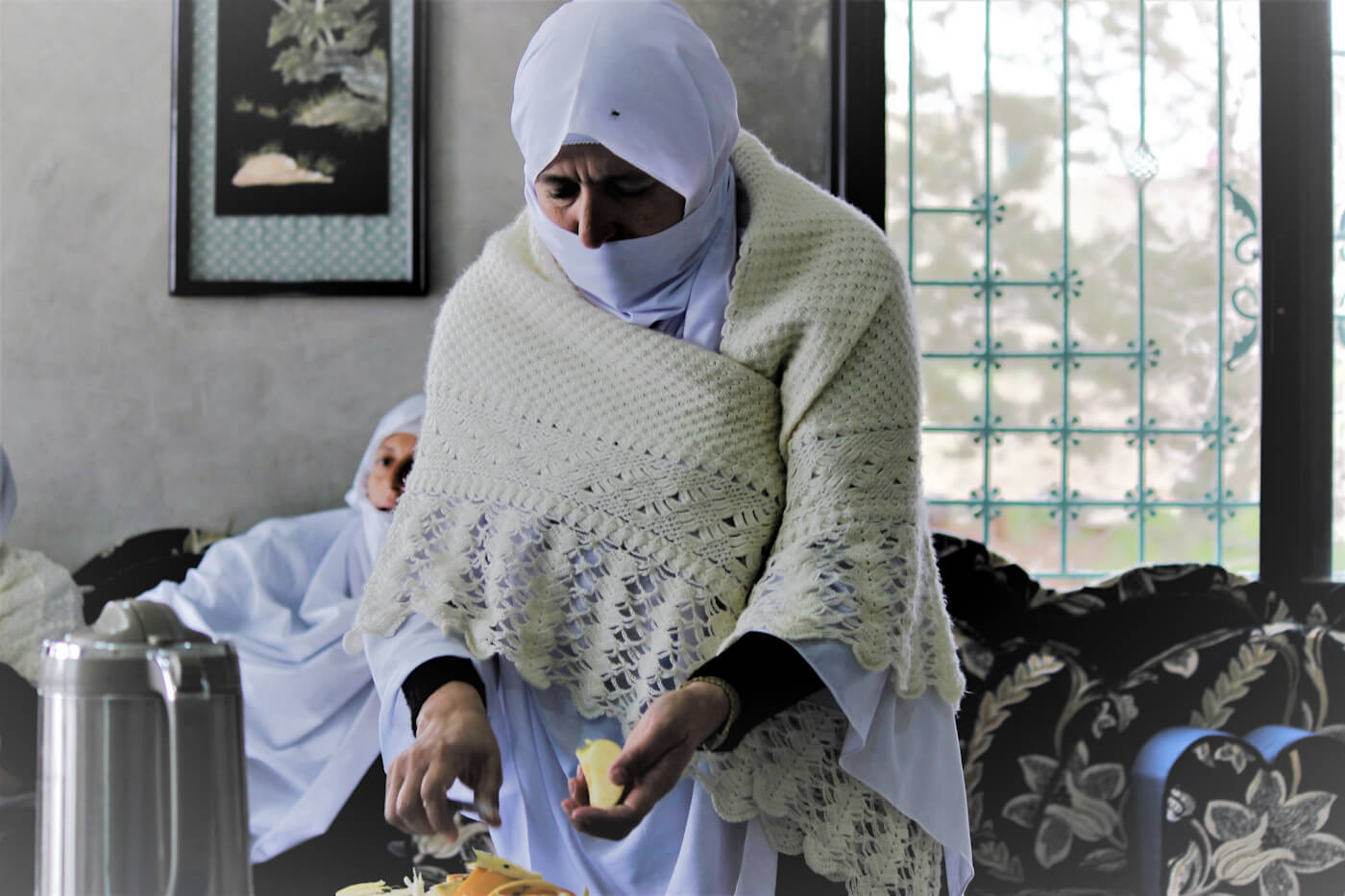
Fadia prepares fruit for the guests in the Madafa after giving her testimony. Photo | Vanessa Beeley
Fadia wept through much of her testimony, the loss of her son still raw despite the relief at their liberation and safe return to their families in Shbeki. She stressed many times that they had returned with their “dignity and honor intact.” She described how Qussai behaved with tenderness and maturity through the experience, taking care of her and the other hostages:
Qussai was a very capable young man for me, his presence with me in captivity, his tenderness, his politeness and his morals; whatever I said to him, he would never say ‘no mum.’ He was loving to the ones who were around me in Sweida, to his uncles and aunts his uncle’s family and his siblings; he was honest with me until the last moment when we were liberated. Even in the moments when we needed water, he brought water for us and didn’t drink a drop of it.”
Fadia’s final words to me were those of a proud and heartbroken mother who had endured horrific trauma and, at the moment of liberation, had been forced to watch her precious child’s life ebb away before her eyes:
Qussai made me feel like it was not a 14-years-old kid who was with me; he made feel that he was a man, a real hero in every sense of the word. He was honest with everyone, he was affectionate with everyone. Praise be to God for His grace, praise be to God. Our God loves him. He took him to His side. Our God loves him and granted him martyrdom and honor.”
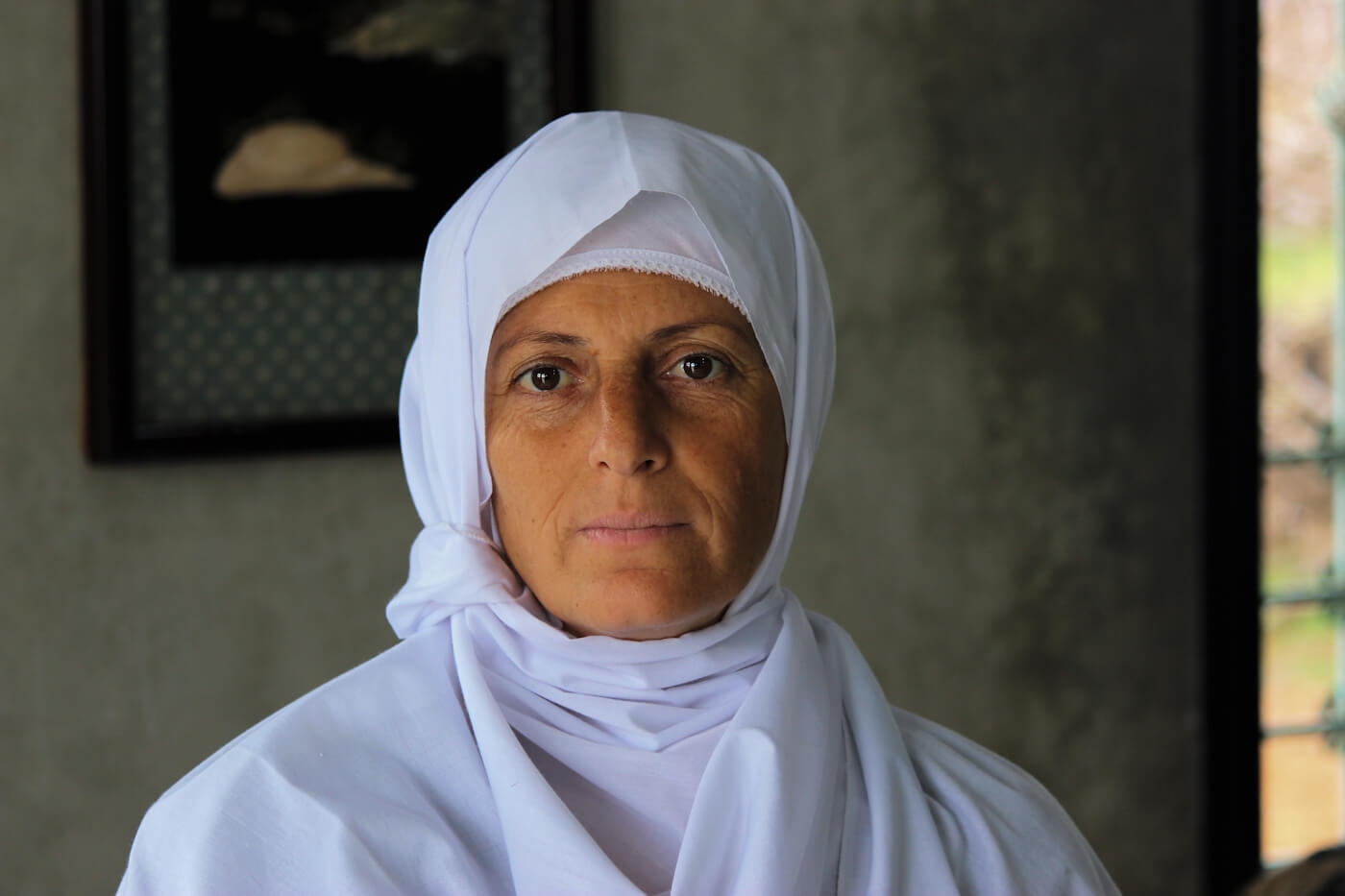
Soad Adib Abo Ammar, one of the ISIS hostages liberated by the SAA on November 8, 2018. Photo | Vanessa Beeley
Soad Adib Abo Ammar is the mother of four-year-old Lamis and twelve-year-old Mirnah, who were also taken hostage by ISIS.
Soad also described how ISIS starved them, abused them and deprived them of water. She expressed anger at how the children were beaten and humiliated by the terrorists:
Torturing our children in front of our eyes was even more severe to us than the torment of being held captive.”
Soad wanted me to transmit the message I hear so often in Syria. Please would people in the West force their governments to stop financing terrorism and to lift the economic sanctions that are a collective punishment for the Syrian people:
Without the West’s support to the terrorists, people wouldn’t have suffered, children wouldn’t have been displaced and we wouldn’t have lost this big number of martyrs. So we demand that Western people put pressure on their governments to stop supporting the terrorists so that we can live with our children in peace.”
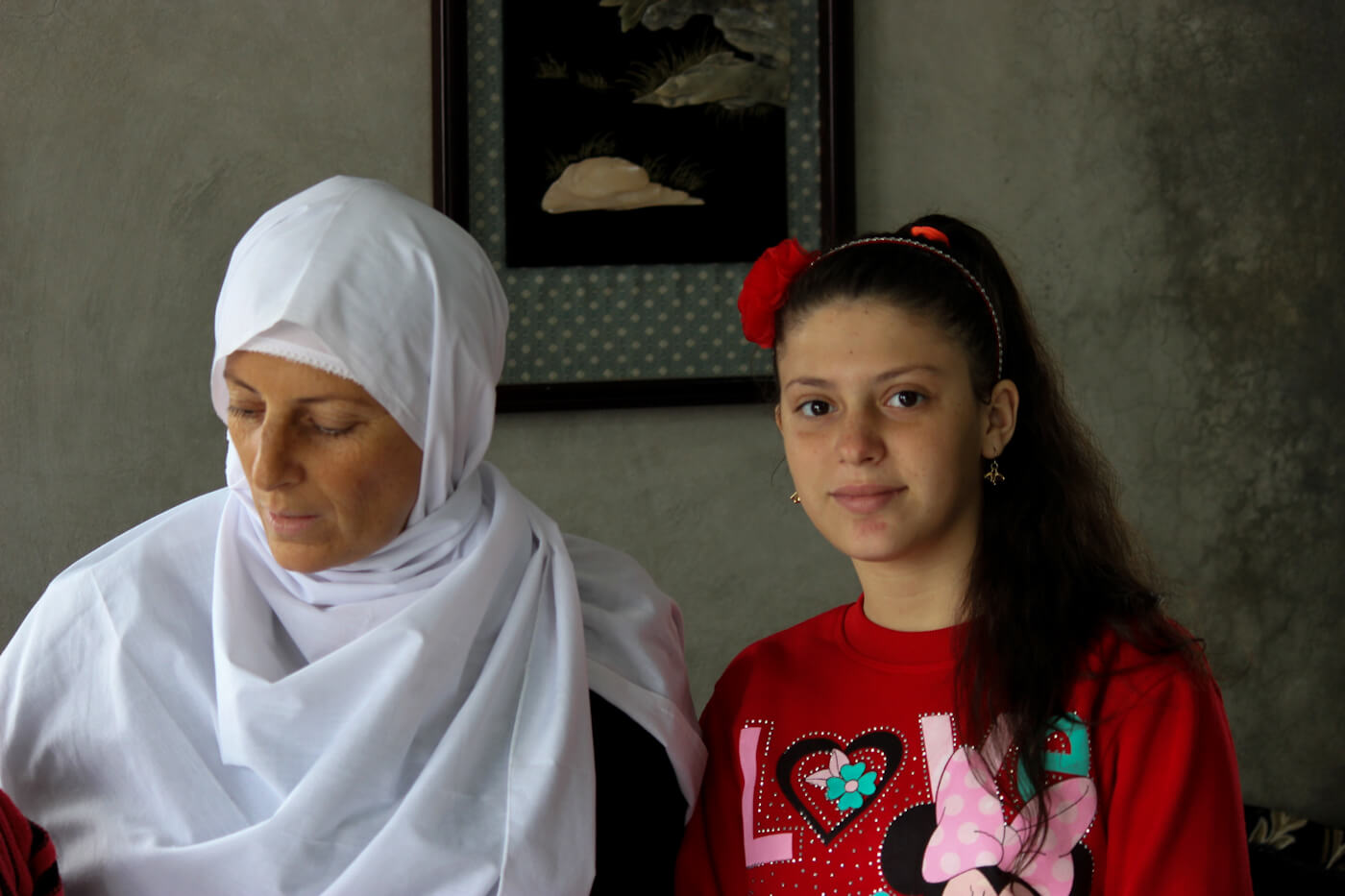
Soad and her daughter Mirnah Hikmat Abo Ammar. Photo | Vanessa Beeley
Soad’s daughter Mirnah told me that she had promised Qussai that she would not go back to school without him. Mirnah sat next to Qussai’s photograph and shyly told me how much she missed him and wished he had returned with her to Shbeki.
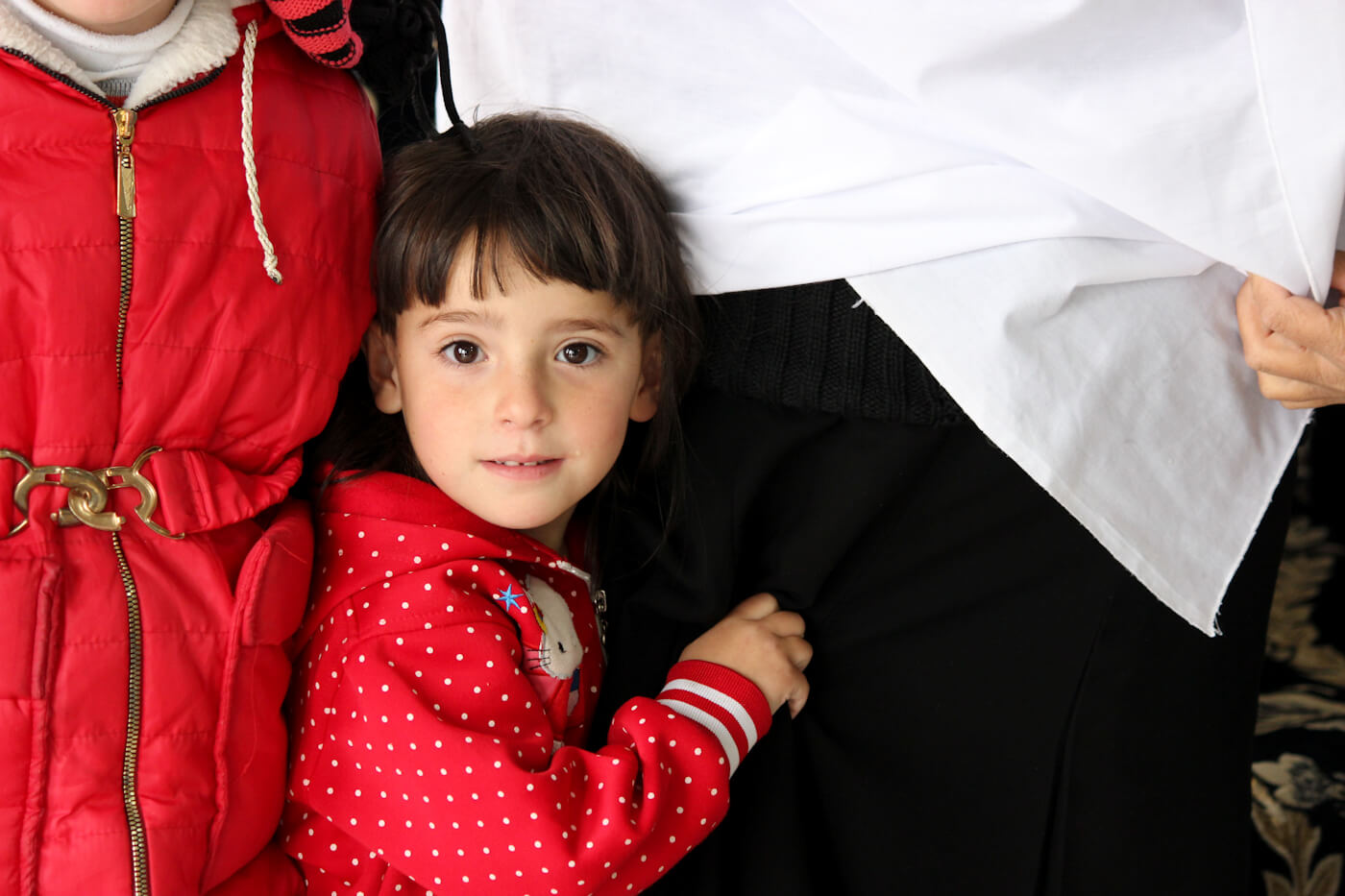
Four-year-old Lamis, daughter of Soad and Hikmat Abo Ammar. Photo | Vanessa Beeley
Soad’s other daughter, four-year-old Lamis, was probably the most visibly affected by the three months of ISIS captivity. She clung to her father, Hikmat Abo Ammar, and initially refused to maintain eye contact. She wore a pair of red, plastic sunglasses that she was clearly hiding behind. She nestled her head into her father’s neck and would turn away if I approached her. Gradually she relaxed and joined some of the other children playing on the steps outside the Madafa, but the need to feel the reassurance of her father’s arms around her would pull her back inside and to her father.
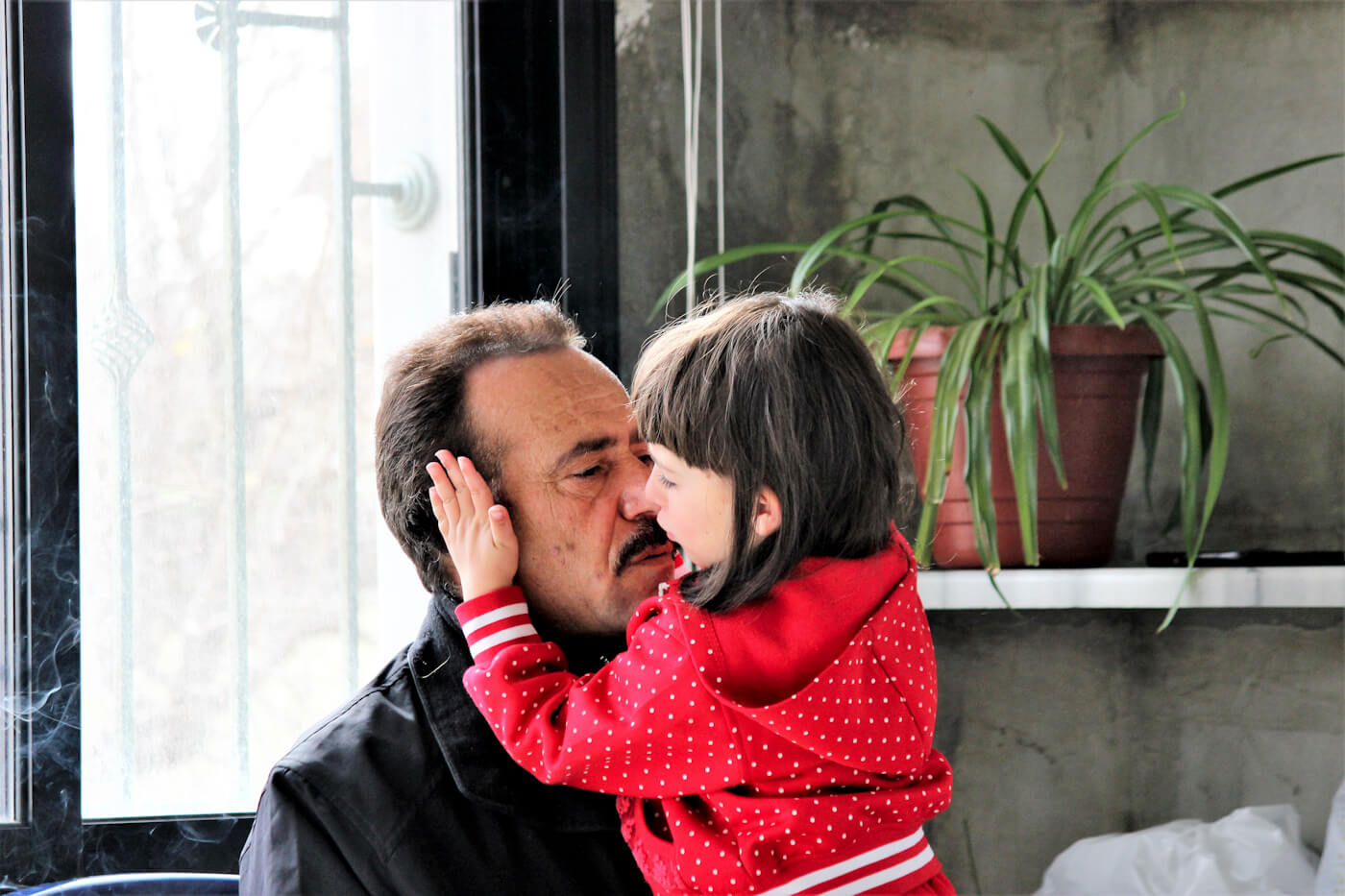
Four-year-old Lamis with her father Hikmat. Photo | Vanessa Beeley
In the following video an SAA soldier scoops a traumatized Lamis up into his arms and asks her if she wants to go home to Sweida on the day of their liberation from ISIS. Then we see Lamis with her father in the Madafa in Shbeki on the day I interviewed the liberated hostages.
Like so many of the other husbands and fathers, Hikmat was working in Saudi Arabia on the day of the attack and was unable to return for five long days. He also described the haunting and devastating tragedy that he was met with upon his return, the long wait for news of his wife and daughters and their eventual return. Hikmat also wanted to ask people in the West to force their governments to stop financing terrorism in Syria.
Hikmat told me that for the duration of the captivity of his wife and children, he couldn’t bring himself to enter their family home.
For three months and 20 days, the period of kidnap, we couldn’t sleep and we didn’t enter our houses because our children were kidnapped so we couldn’t enter them.”
Torment financed by Western governments – and a cry for help
The residents of Shrehi and Shbeki and the five other villages attacked by ISIS on the 25th of July, 2018 have shown extraordinary resilience and fortitude. The dignity of the women I spoke to shone through the trauma they had been forced to experience and the losses they had suffered. The pride in the resistance of a handful of inexperienced local fighters who fought off an attack by a well-equipped, battle-hardened gang of terrorist criminals was expressed by all with whom I spoke.
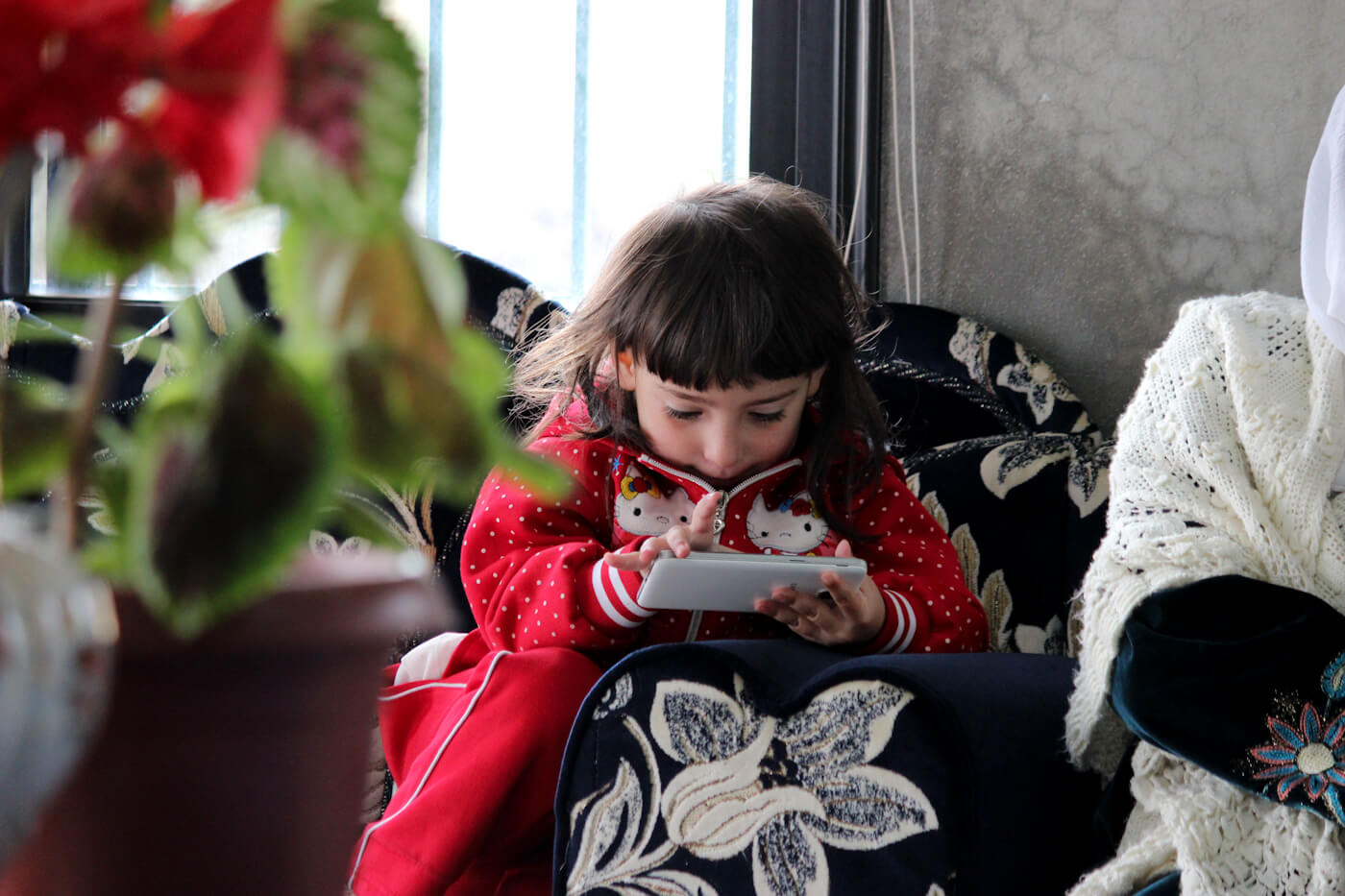
Lamis playing with her father’s mobile phone in Shbeki. Photo | Vanessa Beeley
The fact remains: this massacre should never have happened and it happened because Western governments are financing and arming the terrorist gangs that have invaded Syria. As OHCHR spokeswoman Shamdasani said in their report on the Sweida bloodbath:
The transfer of armed fighters with a history of gross human-rights abuses and contempt towards international law, can mean an increase in the likelihood of violent attacks against civilians like the ones carried out last week in As-Sweida.”
What Shamdasani fails to clarify is that it is the U.S. coalition and its allies, their aligned media and “humanitarian” NGOs are effectively protecting, supporting and enabling the existence of these “gross human rights abusers.”
During my first visit to Shrehi and my conversations with Khaled Saab whose mother, father, brother and cousin had been murdered by ISIS in their family home, the overriding message that I was given by the still grieving civilians was best expressed by Khaled’s words that he spoke so passionately to me:
We defended our land and our homes because this land is mixed with the blood of generations of our people. We will not accept that people without morals or humanity can touch this land. We stay, we will stand and defend this land until we die. Our youth killed these terrorists even though they had very old weapons, very simple weapons. The ISIS fighters had modern, expensive equipment but we still defeated them.” ~ Khaled Saab in Shrehi
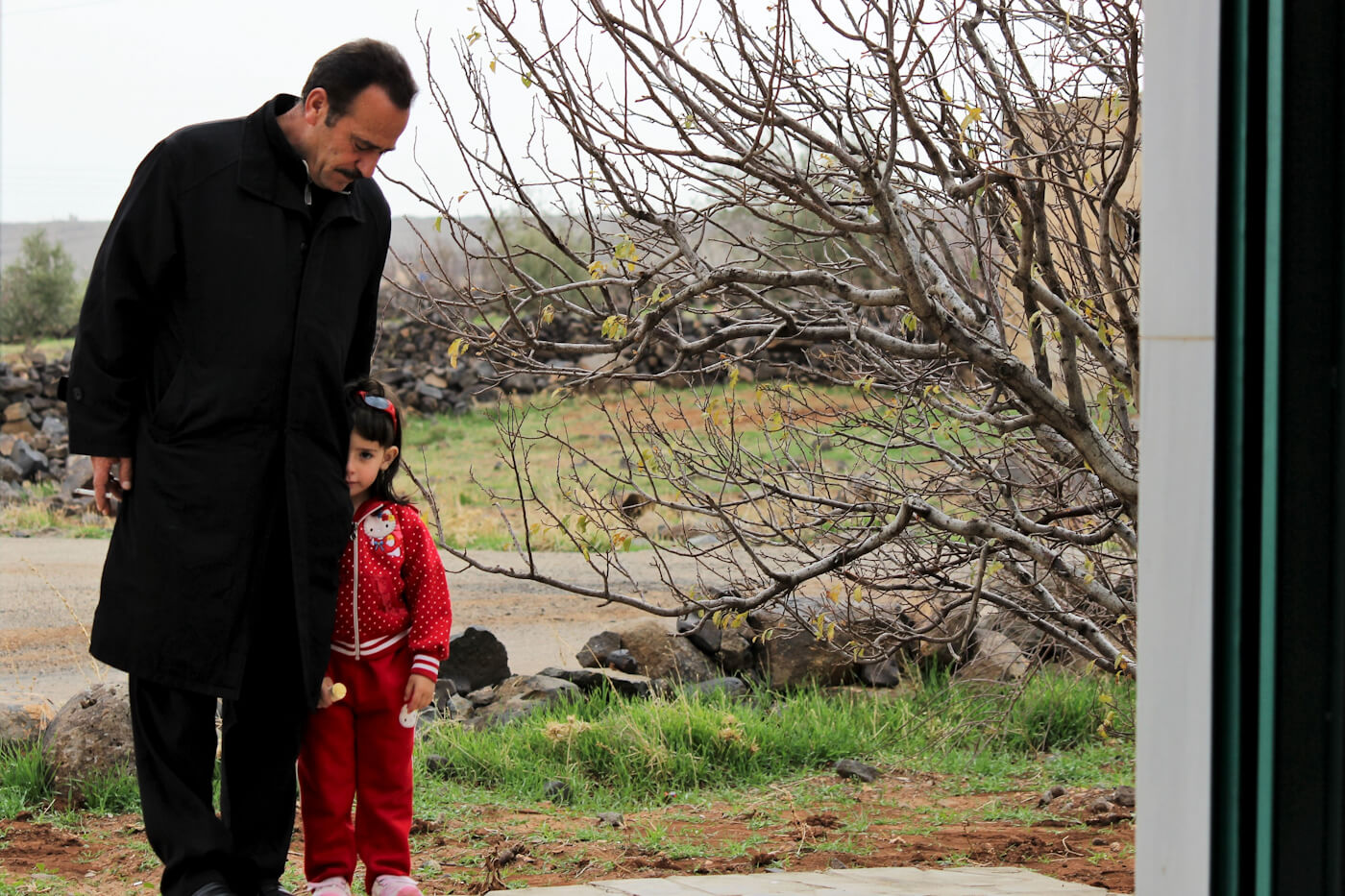
Lamis clinging to her father at the entrance to the Madafa. Photo | Vanessa Beeley
The Syrian people know who is responsible for their suffering and they have pleaded with us to do something about it. We owe it to four-year-old Lamis, the child martyrs Qussai and Raafat and an entire generation of war-traumatized children across Syria to respond to their call for action.
Watch | An appeal to the West, from another Shbeki resident, Diaa Abo Ammar
Top Photo | In this photo released by the Syrian official news agency SANA, women and children who were rescued from the ISIS after they arrived to the southern province of Sweida, Syria, Nov. 9, 2018. SANA | AP
Vanessa Beeley is an independent journalist, peace activist, photographer and associate editor at 21st Century Wire. Vanessa was a finalist for one of the most prestigious journalism awards – the 2017 Martha Gellhorn Prize for Journalism – whose winners have included the likes of Robert Parry in 2017, Patrick Cockburn, Robert Fisk, Nick Davies and the Bureau for Investigative Journalism team. You can support Vanessa’s journalism through her Patreon Page.
The post The ISIS Massacre in Sweida: A Story of Torment and Resilience for an Uninterested World appeared first on MintPress News.
